17 Century American Art 17 Century American Landscape Art
Museum of the City of New York/Archive Photos // Getty Images
l photos from American life in the 19th century
Photographs have a style of capturing emotion. A photo may echo sadness and desperation, equally is the case with Dorothea Lange's 1936 photograph known as "Migrant Female parent," showing a distraught mother and her children during the Great Depression. Information technology may capture the spirit of triumph, as is accomplished with John Rooney's iconic 1965 shot of boxing heavyweight champion Muhammad Ali continuing over opponent Sonny Liston. A photograph can as well announced to signify promise and joy, à la Alfred Eisenstaedt's "V-J Day in Times Foursquare."
Regardless of the scene or sentiment that is captured in a photograph, images from throughout history have the ability to freeze moments in time. In doing so, they permit future generations to peer into the past and obtain glimpses into life earlier their own, whether information technology'south the major events (due east.g., Nat Fein'south "The Baby Bows Out" or Abraham Zapruder'due south "JFK Bump-off, Frame 313") or the small moments (e.k. W. Eugene Smith'south "Country Doctor," or the first-e'er cell phone photo, Philippe Kahn'south image of his newborn daughter's first moments).
Like any fourth dimension period in the age of photography, the 1800s in America has been widely chronicled, in images dating dorsum to the early years of the century. A wait back on the images will take viewers to the country's showtime boardwalk in New Bailiwick of jersey, brand them grapple with the realities of the Civil War, and bring them along a journey to detect the evolution of transportation over the course of the decades.
To larn more about 19th-century America through photographs, Stacker compiled a collection of l essential images that capture what life was like in the 1800s. Photos are sourced from a broad range of government databases and national photo libraries. From photos depicting iconic inventors and activists in action, to those only depicting a day on the embankment, each of these images shines a light on a pocket-size corner of American life betwixt 1800 and 1899. Read on to view fascinating images and learn more about the events and trends that shaped 19th-century America.
You lot may also like: 100 iconic photos that capture 100 years of world history

i / fifty
1890: Couple walks forth the beach in Atlantic Urban center
Seaside socializing rose to popularity in the 19th century, commencement in United kingdom of great britain and northern ireland where doctors were encouraging embankment visits as a manner to combat "melancholy," and later on in America every bit the tendency striking the Eastward Coast. The starting time boardwalk stateside was built in Atlantic Urban center in 1870 by two men—a hotelier and a railroad conductor—who had grown aggravated with beachgoers consistently dragging sand into their resorts and railroad train cars. It was very basic, consisting only of an arrangement of boards laid out on the sand, and was later replaced by a larger railed boardwalk in 1890. In this photo, people stroll along the sand at the New Jersey beach, with the boardwalk in the background.
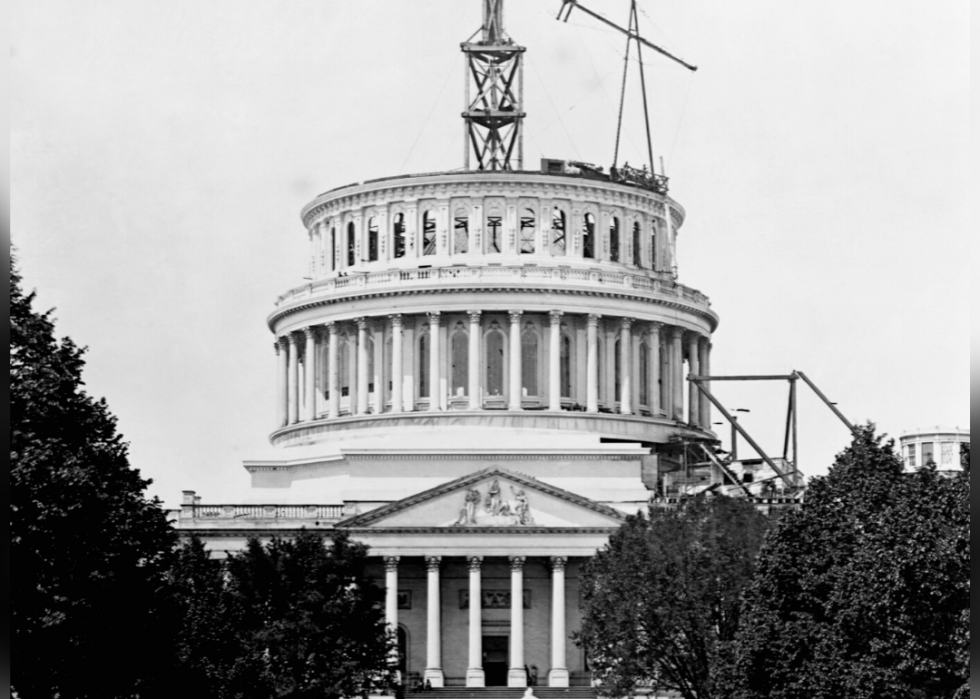
2 / l
1855: U.Southward. Capitol dome under construction
The dome of the U.S. Capitol was designed past Philadelphia builder Thomas U. Walter, who took on the project afterward entering a competition to pattern an extension of the Capitol. While the authorities building had an original dome added in the 1820s, additions to the Capitol over the subsequent years made the original dome experience too small. This photo shows the Capitol dome under construction, equally the original wood-covered copper structure was replaced by Walter's new and improved cast iron design.
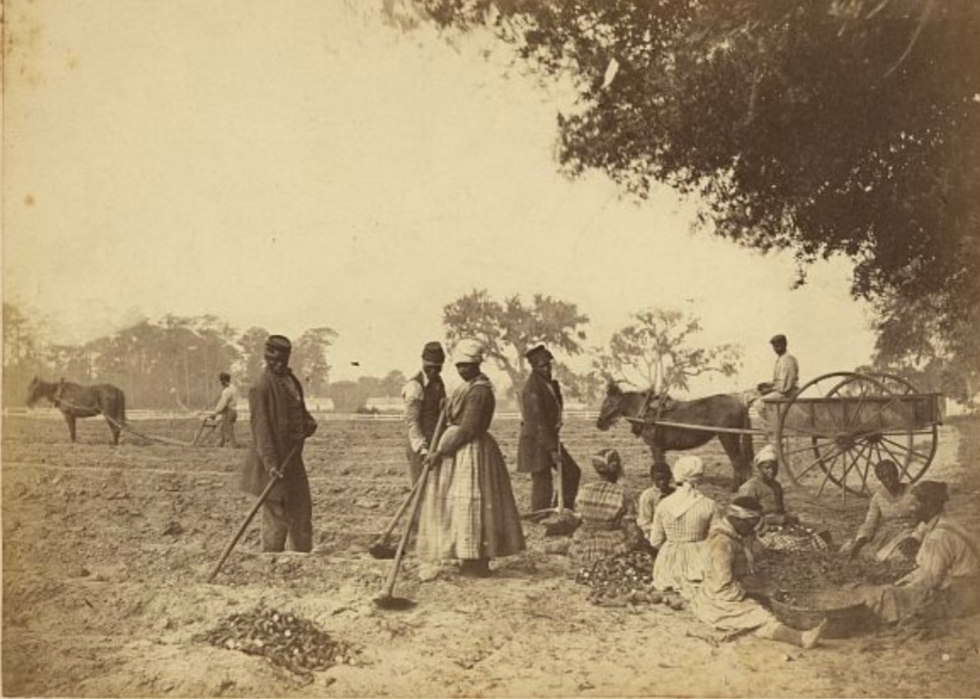
3 / fifty
Henry P. Moore // Library of Congress
1862: Enslaved people harvest sugariness potatoes on Hopkinson's Plantation
The Emancipation Announcement, which declared all slaves held in rebel states be free, was signed into upshot by President Abraham Lincoln on Jan. 1, 1863. That was merely a yr after this photograph by printmaker and lensman Henry P. Moore was captured. The prototype depicts a group of enslaved people as they work a sweetness potato plantation in Due south Carolina.
It has been suggested that the image was staged by Moore as role of a larger statement about the condition of slaves in the land, fifty-fifty as they were on the cusp of liberty. Particularly, the argument has been that even with possible freedom on the horizon, the emotionless attitudes of the figures in the photograph could be Moore'southward style of depicting the struggles that would still prevarication ahead, even in a society freed from slavery.
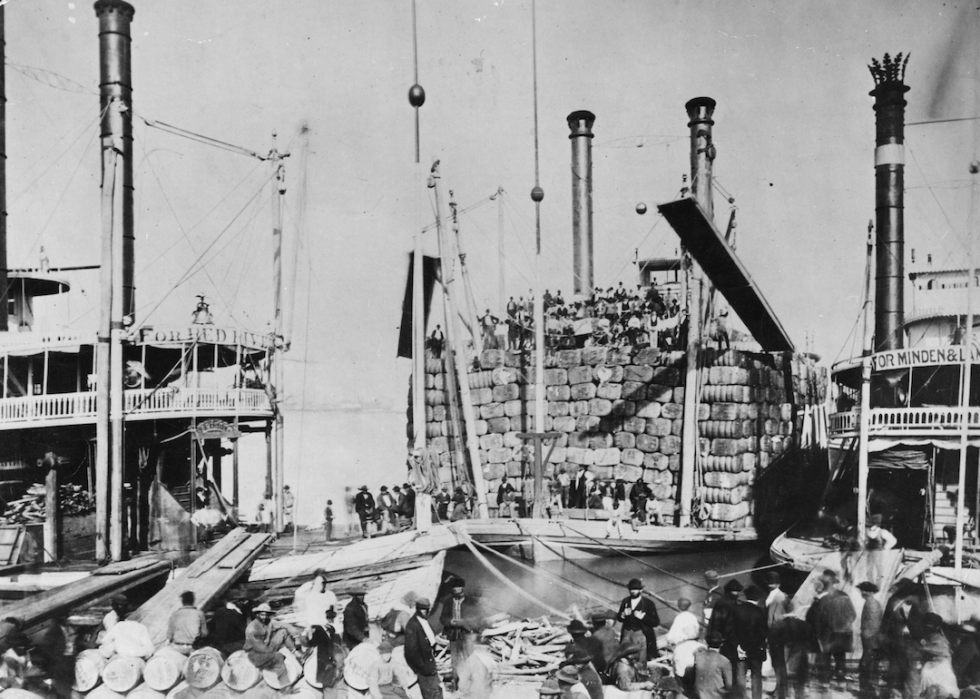
four / 50
Otto Herschan Collection/Hulton Archive // Getty Images
1870: Docks of New Orleans in Louisiana
The Port of New Orleans has long been considered a major point of commerce in the United States, due to its instrumental location along the Mississippi River. The river is the country'due south largest and is a fundamental point of transportation for goods, with the Port of New Orleans playing a role in the movement of primal national exports like grain. In this photograph, the docks of the busy New Orleans port are captured with loads of cargo and ships existence loaded for transportation along the Mississippi.
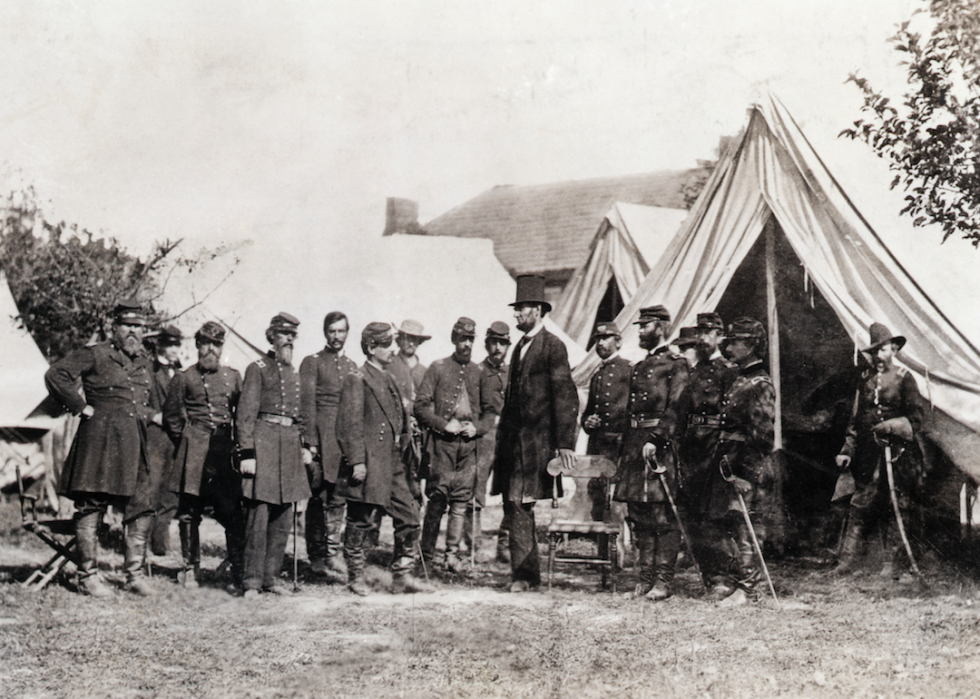
5 / 50
1862: Lincoln visits a Civil State of war campsite in Maryland
The Battle of Antietam was the bloodiest unmarried-mean solar day battle in American history, in which Union General George B. McClellan and his men successfully forced the troops of Confederate General Robert East. Lee out of Maryland and thwarted his efforts to invade the n. This photo shows and then-president Abraham Lincoln visiting McClellan and his troops at their camp near Sharpsburg, Maryland, where the president attempted to persuade McClellan to attack Lee'south troops while the Union army had the upper hand. Refusing to comply, McClellan was dismissed from his rank soon after.
Yous may likewise like: Nigh popular infant names in America
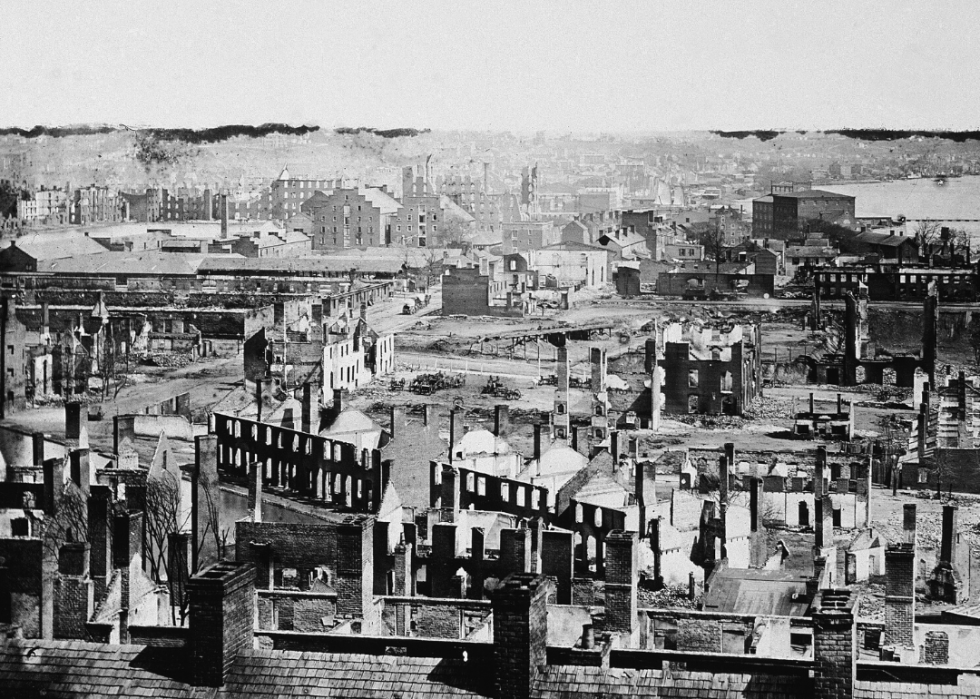
half dozen / 50
Hulton Annal // Getty Images
1864: Civil War destruction in Richmond, Virginia
During the Civil War, Union General William T. Sherman's belief was that a "total war" approach was perfectly logical and justifiable in the fight confronting the Confederates, writing in a letter to Army Officer Henry Halleck in December 1864 that Union soldiers were "not merely fighting hostile armies, but a hostile people." In an try to scare Georgia civilians into abandoning the Amalgamated cause, Sherman proposed a March to the Sea, in which he and 62,000 of his men traveled 285 miles from Atlanta to Savannah, Georgia. Though Sherman'south goal was non to blindly destroy everything that lay in his troops' way, his men were instructed to fire down the homes and barns of anyone who attempted to fight them.
Though the march was ultimately considered a win for the Marriage cause, it caused a good deal of damage along the manner. Here, an image captures the destruction that was caused in Richmond during the course of the march.
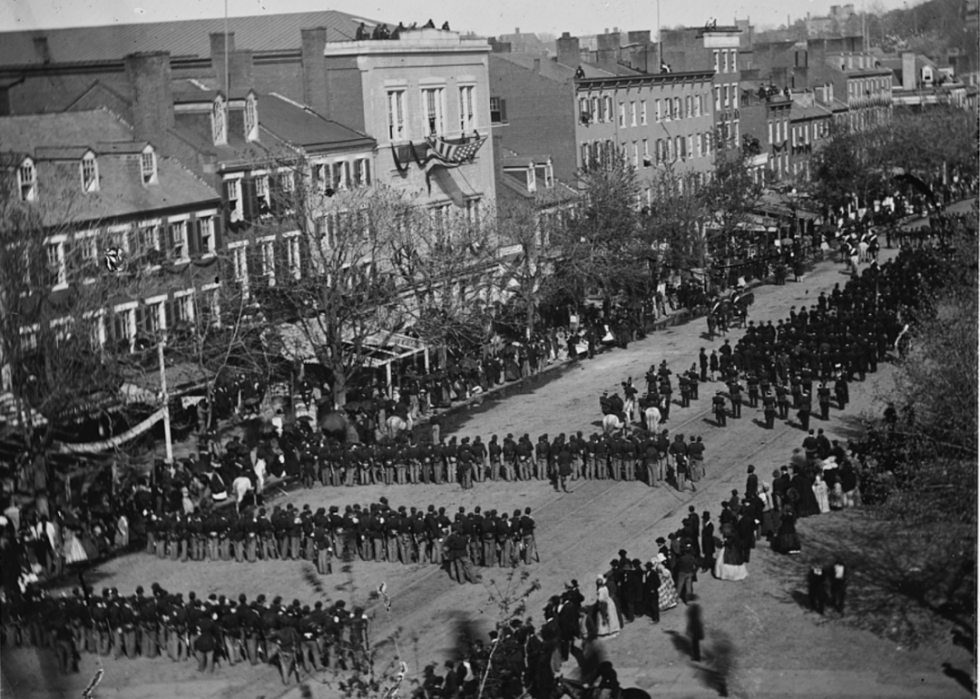
7 / 50
Brady Handy Collection // Library of Congress
1865: Lincoln's funeral on Pennsylvania Artery
On April fourteen, 1865, President Abraham Lincoln was assassinated at Ford's Theatre by stage actor and Confederate sympathizer John Wilkes Booth. Abraham Lincoln's 1,700-mile funeral procession, which was the outset to involve travel by train, traveled through more than 400 communities in 6 different states, in add-on to the land'southward capital, betwixt Apr xix and May 3. Hither, the funeral procession is shown as it moves forth Pennsylvania Avenue in Washington D.C.
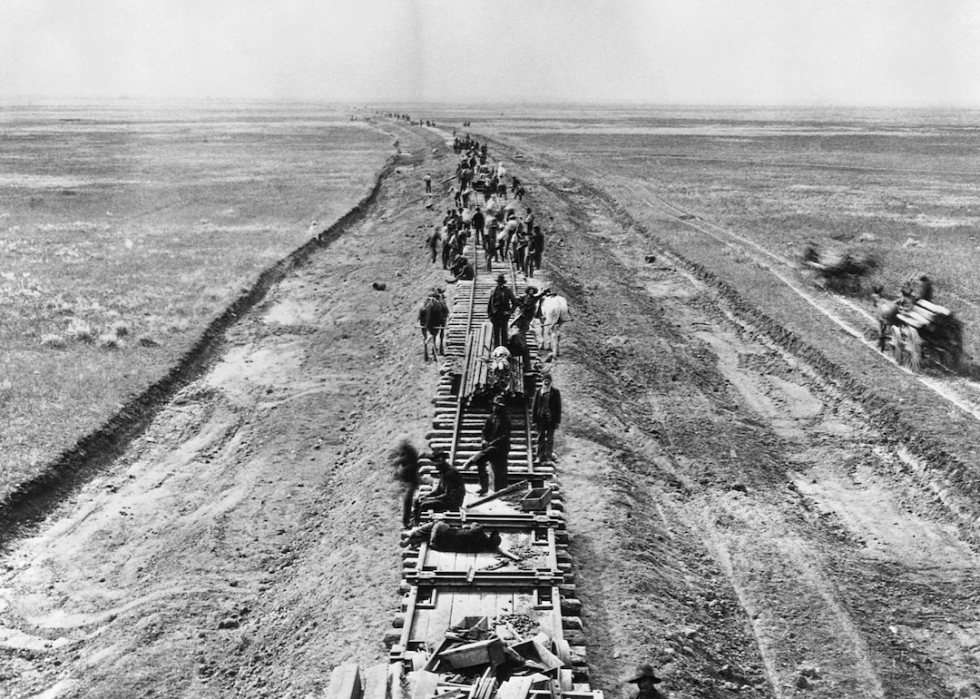
viii / 50
Minnesota Historical Society/CORBIS // Getty Images
1887: Construction of St. Paul, Minneapolis, and Manitoba Railway
The St. Paul, Minneapolis and Manitoba Railway was America's largest rail organisation and the start of what subsequently became the Slap-up Northern Railway, which ran from St. Paul, Minnesota, to Seattle, Washington. It was congenital to replace the St. Paul and Pacific Railroad, which had gone broke. Led by Canadian American railroad executive James J. Hill, the structure of the St. Paul, Minneapolis and Manitoba Railway began in 1879 and was completed in 1893. This photograph shows the construction of the railroad in Montana.
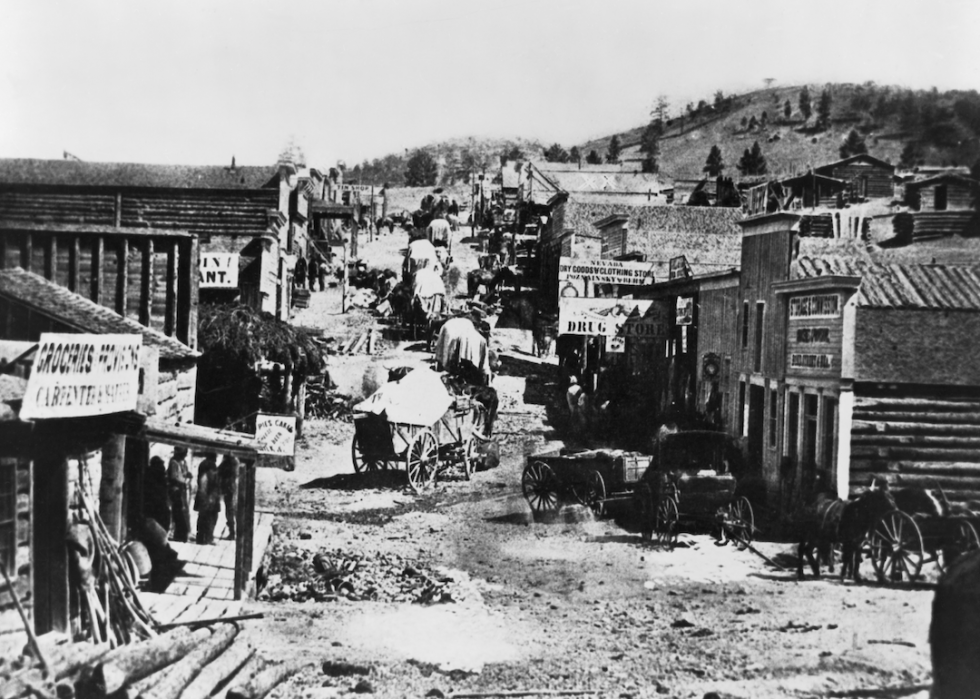
9 / 50
1865: Helena, Montana, as a frontier boondocks
Montana officially became a territory in 1864, later on hopeful prospectors began flooding into the region during the gold rush. The swift spike in population that came with the migrations gave rise to what were known as "boomtowns," or "frontier towns," which are substantially quick-to-materialize towns that emerge when settlers land in a new region. Here, a frontier town in Montana's upper-case letter, Helena, is shown.
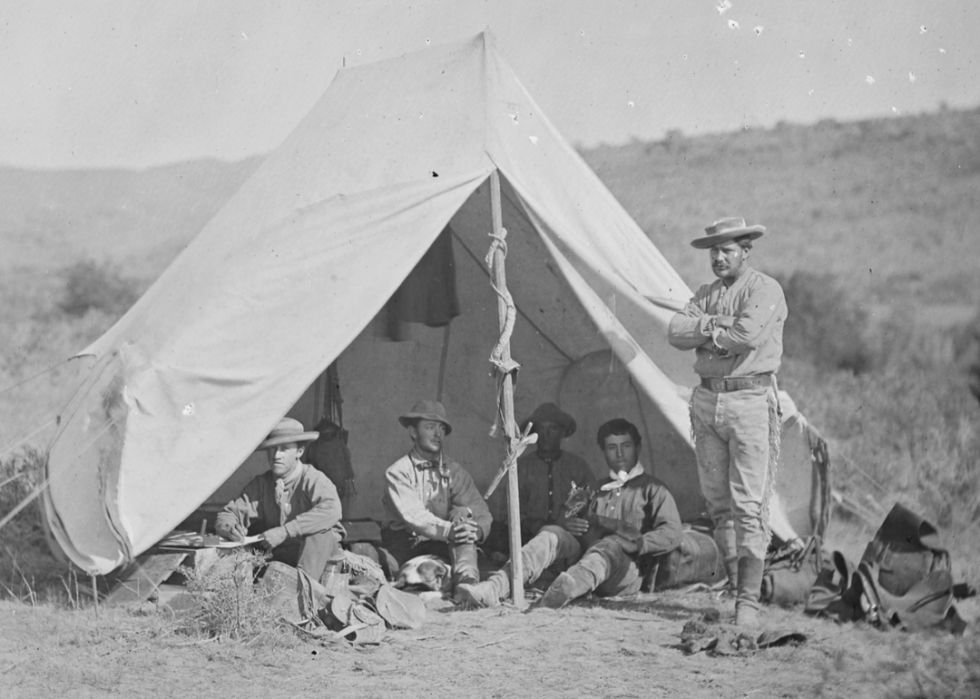
10 / fifty
William Henry Jackson/NARA // Wikimedia Commons
1872: Camp study of expedition
The role of geological surveying and land mapping played a critical role in understanding western lands existence explored in the 19th century. Lensman William Henry Jackson was a key histrion in such projects, as he spent a good part of the late 1800s working with the U.S. government to survey regions around Yellowstone River and the Rocky Mountains. Jackson's job was to capture images of these new territories to create a documented account of the landscapes. This photograph by Jackson shows the survey team of an 1872 expedition as they sit down by their camp.
You may also like: The women who have won the Nobel prize
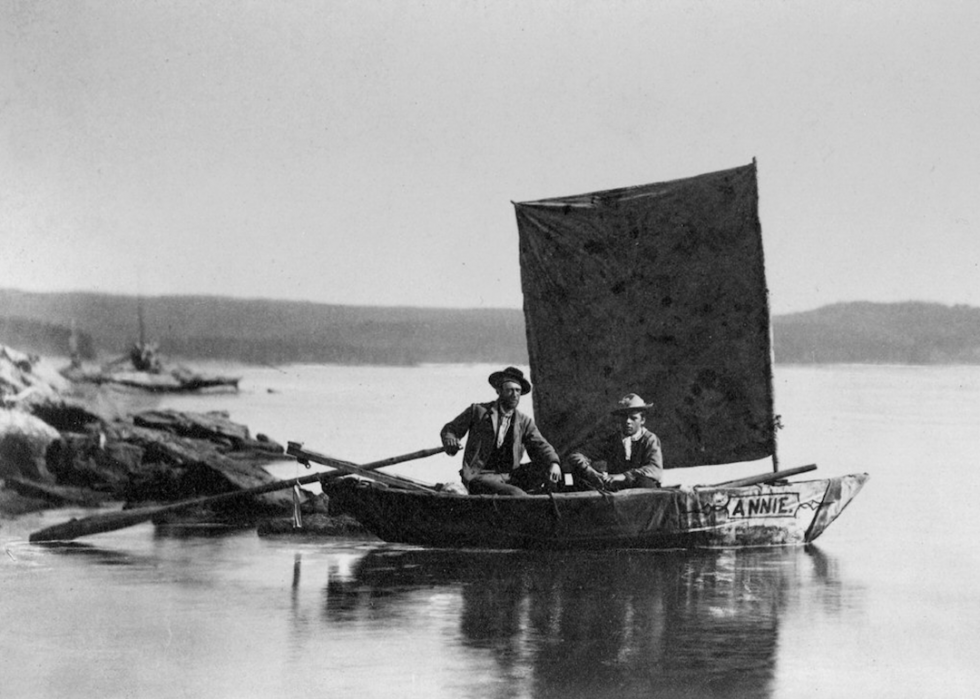
11 / 50
William Henry Jackson/USGS // Wikimedia Commons
1871: The Annie sails on Yellowstone Lake
The U.Due south. Congress in 1872 made Yellowstone the world's outset government-recognized national park. Photographer William Henry Jackson captured this photo for the 1871 Hayden Geological Survey. The prototype depicts The Annie, the first boat to sail on Yellowstone Lake.
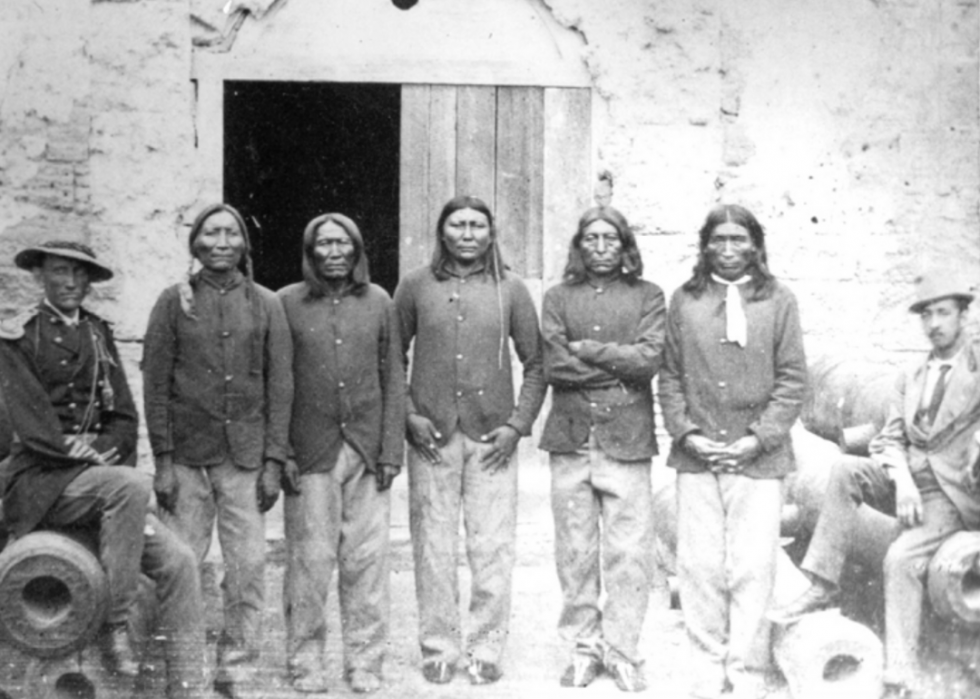
12 / 50
Public Domain // Wikimedia Commons
1875: Native American prisoners of the Ruby-red River State of war
Equally an increasing number of Americans headed due west during the 19th century, the U.S. government tried to shrink or totally eliminate Native American tribes settlers came in conflict with forth the mode. The Scarlet River War, a military campaign that took identify in 1874 and 1875, was an effort to remove several Southern Plains tribes—Comanche, Kiowa, Southern Cheyenne, and Arapaho—from Texas territory. This photo depicts American Indian war prisoners in Florida, where 74 tribal leaders were imprisoned.
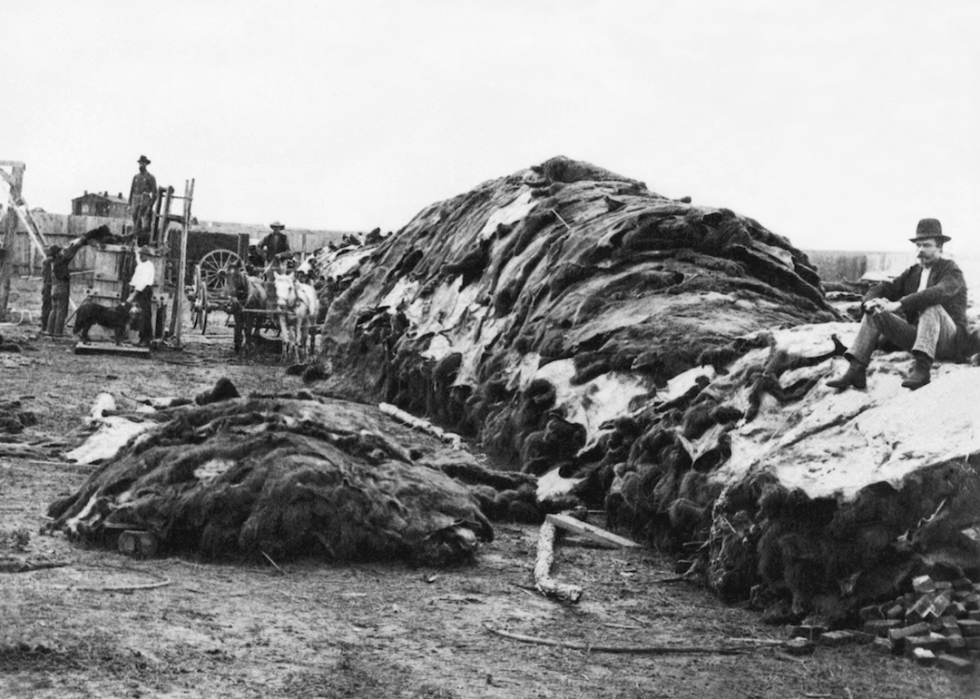
13 / l
Underwood Archives // Getty Images
1878: Buffalo hide grand in Contrivance City, Kansas
When the railroad arrived in Contrivance Metropolis, Kansas, in 1872, it brought with information technology a desperate shift in how buffalo native to that region were hunted. While the animals were once killed primarily for food in addition to their hides, the railroad introduced an element of commerce that ultimately gave rise to a thriving buffalo hide industry. This photo shows Charles Rath—one of the greatest buffalo hunters of the 1800s—sitting on a rick of some 40,000 buffalo hides in 1878.
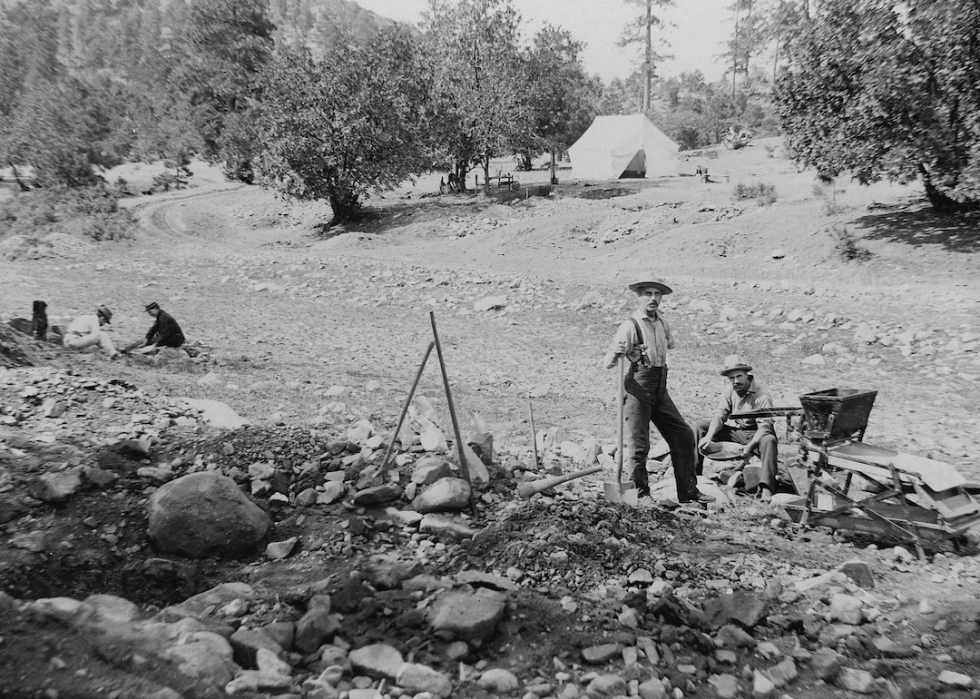
fourteen / 50
Will R. Beatty/Buyenlarge // Getty Images
1885: Placer miners in Prescott, Arizona Territory
Placer mining is a method of using water to excerpt heavy minerals similar gilded and chromite from the earth. Panning, which was the method that gilded miners used in the 19th century, is one early on iteration of placer mining, by which prospectors would detect gold past separating it from other minerals and the soil according to their density and gravity. This photograph captures a scene involving several placer miners as they search for minerals in Prescott, Arizona Territory.
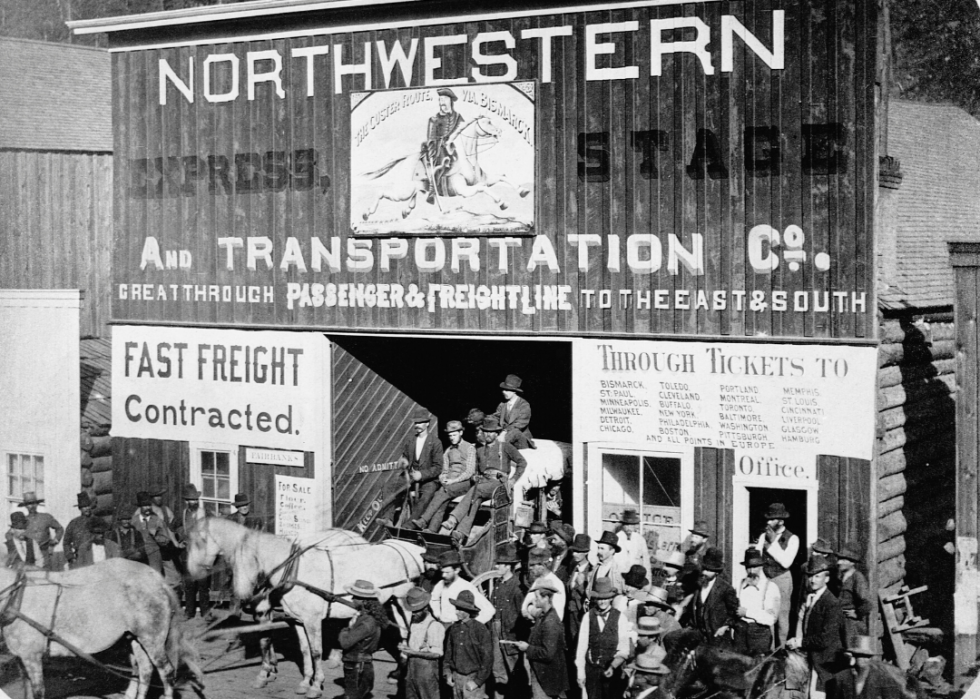
15 / 50
Minnesota Historical Society/CORBIS // Getty Images
1880: Northwestern Express Stage and Transportation Co. in South Dakota
Hallmarks of long-altitude stagecoach travel in the 19th century were pit stops every few hours during which coach drivers could swap out their horses and give passengers a chance to residuum and eat (hence the name stagecoach: transportation occurring in stages).
Even though the introduction of railroad travel in the latter half of the century added a new mode of transportation to choose from, stagecoaches remained a popular fashion of transportation, particularly in more rural regions. In this photo, a major stagecoach station in South Dakota—the Northwestern Express Phase and Transportation Co.—is shown as a motorcoach prepares to start its journey.
Y'all may also like: Scientific breakthroughs from the year you were born
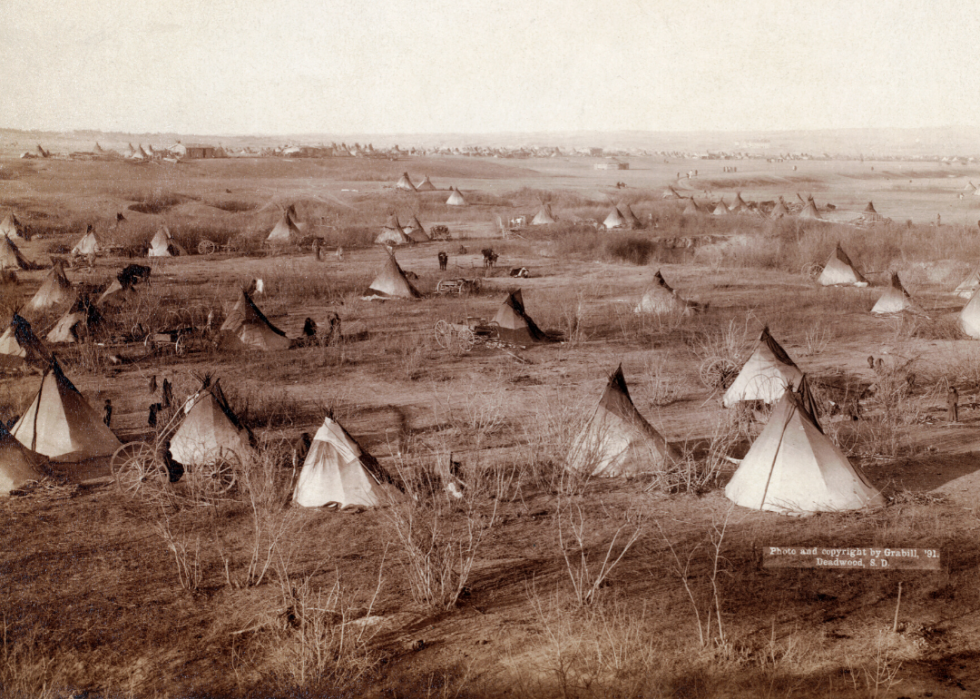
16 / 50
John C.H. Grabill // Getty Images
1891: The Peachy Hostile Camp of the Lakota Sioux tribe
In 1890, the ongoing conflict between the U.Southward. military and Native Americans erupted on the Lakota Pine Ridge Indian Reservation in Southward Dakota. Wounded Articulatio genus became the site of a massacre—and the final clash between the U.Due south. government and the Plains Indians—in which 250 Native Americans were killed. This image depicts the mural of a Lakota village on the Pine Ridge Reservation.
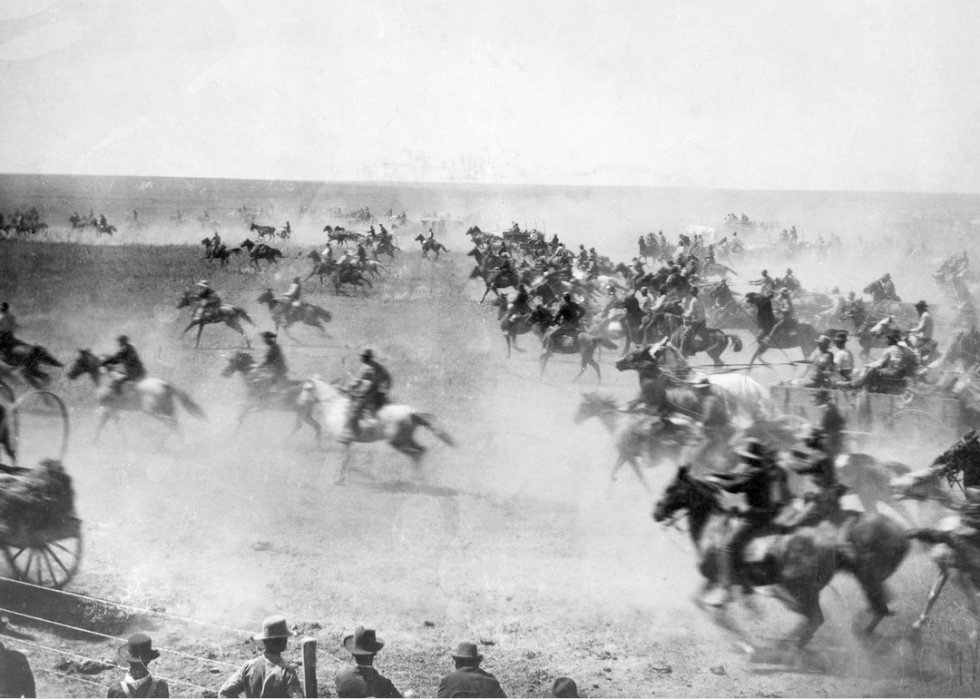
17 / l
1893: Oklahoma Land Run of 1893
Past 1893, there had already been a number of land rushes in Oklahoma Territory, including the land blitz of 1889, when President Benjamin Harrison opened up a i.9 million-acre area of what had been Native American territory for western settlement. This photo depicts the Oklahoma Land Run Sept. 16, 1893, in which around 100,000 land-hopeful settlers raced westward on trains, horses, foot and wagons to try to claim land for themselves and their families. With only 42,000 parcels of country available, however, most of the settlers would come out of the land rush with zero to testify for information technology.
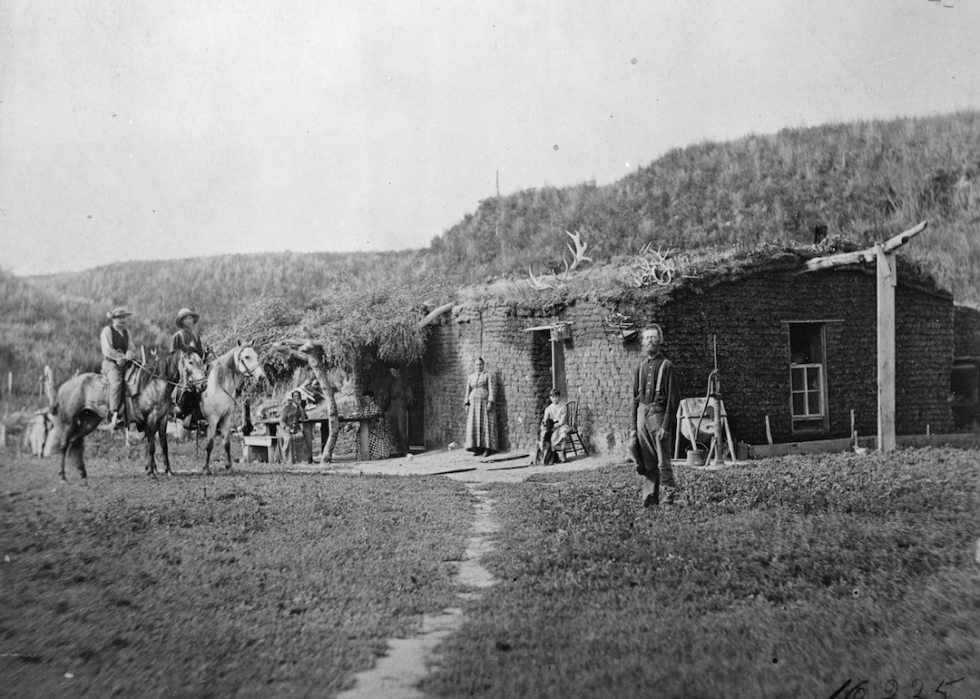
xviii / 50
PhotoQuest // Getty Images
1887: Sod house in the Nebraska plains
As Americans built homesteads throughout the Great American Prairie, one of the biggest struggles was the lack of ideal materials to work with for building. Without a natural supply of mutual materials similar wood or rock, prairie homesteaders were often left to rely on sod: grass and the layer of soil and roots directly below it. In this photo, a family stands in front of their sod business firm in Nebraska.
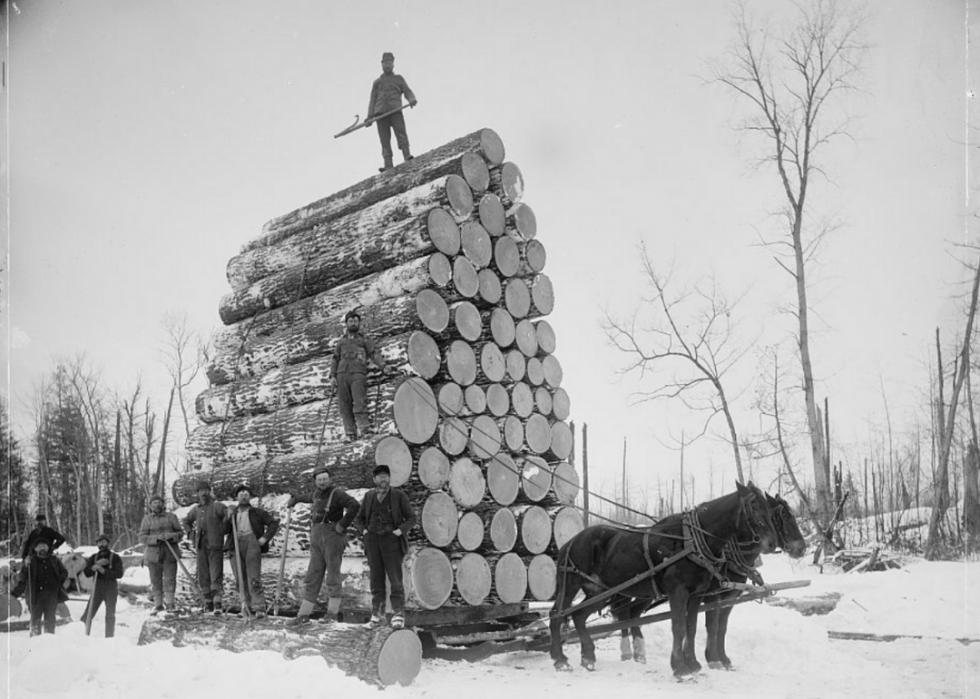
19 / 50
Detroit Publishing Company // Library of Congress
1880: Load of lumber
Michigan's vast landscapes of pino trees and hardwoods made the region a key actor in the 19th-century lumber industry. This photo shows a sled pulling loads of lumber in 1880, at which point Michigan had become the largest lumber producer in the land. Sleds were instrumental in moving massive logs on manmade ice-covered roads when but dragging them from the forest wasn't a feasible pick.
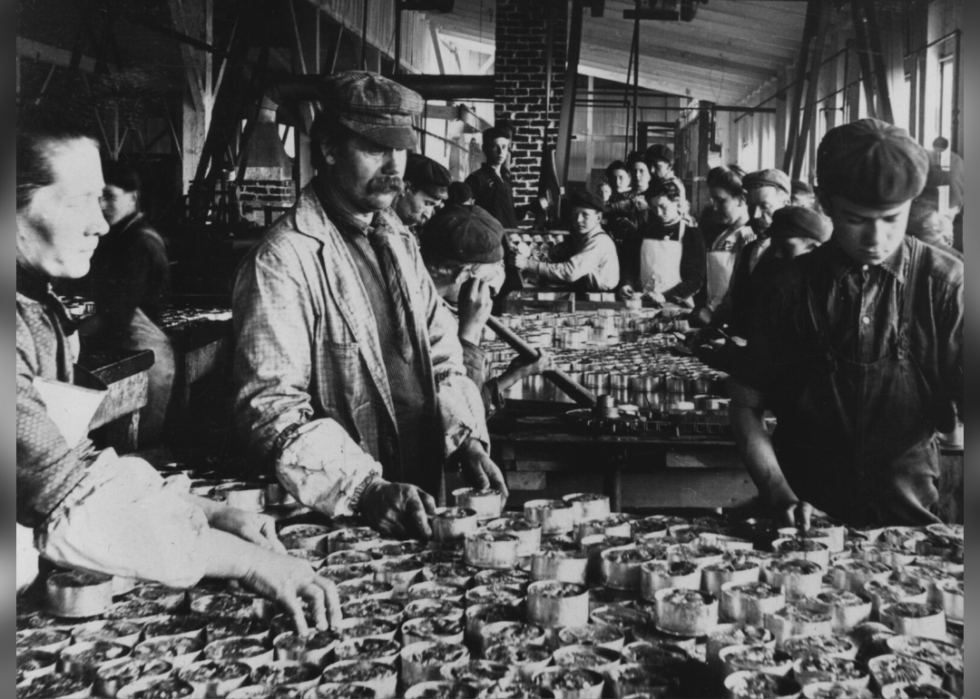
20 / fifty
Archive Photos // Getty Images
1890: Oregon salmon canning establishment
Merely similar Michigan was a valuable territory because of its loftier supply of lumber, other regions throughout 19th-century America quickly developed industries based on the unique natural resources of those areas. In the belatedly 1800s, salmon-canning was a rapidly growing industry along the Columbia River in Oregon. In the 1880s, salmon canning reached its tiptop in the region, with a total of 39 operating canneries.
This photo depicts workers at an Astoria, Oregon, canning establishment in 1890, which marked the beginning of the salmon industries slowing thanks to overfishing in preceding years. The terminal cannery along the Columbia River closed in 1980.
Y'all may also like: Infinite discoveries that will blow your heed
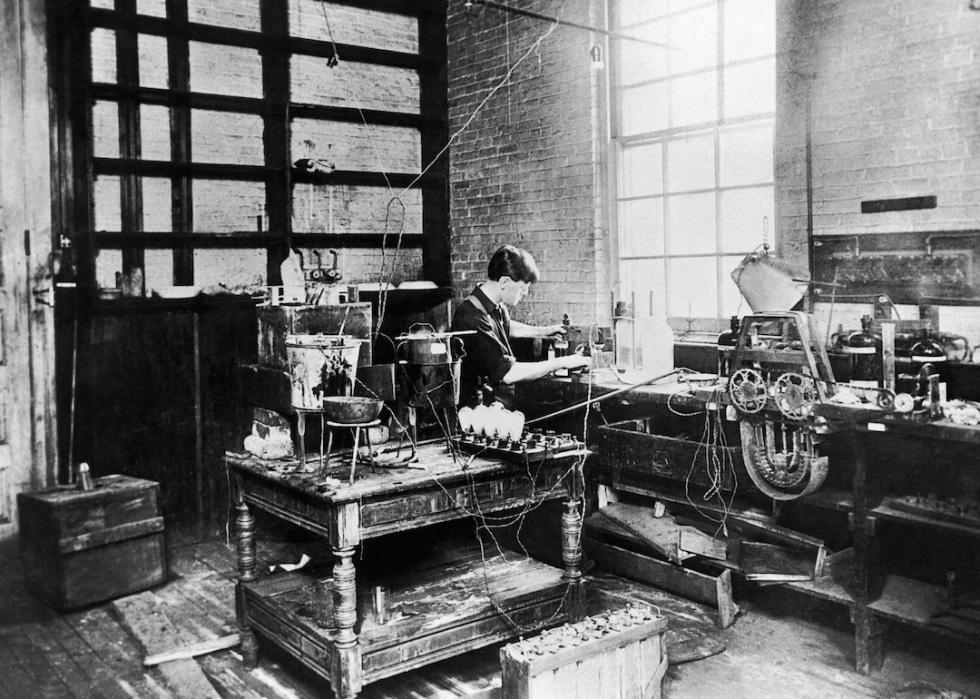
21 / 50
Keystone-France/Gamma-Keystone // Getty Images
1870: Thomas Edison in Newark laboratory
Though Thomas Edison is well-nigh commonly remembered for his invention of the incandescent lightbulb, the prolific inventor'south piece of work extends far beyond that, with a tape 1,093 patents to his name. In this photo, a young Edison works in his New Jersey laboratory. Edison perfected his lightbulb in 1879 later more than a yr of tinkering and testing.
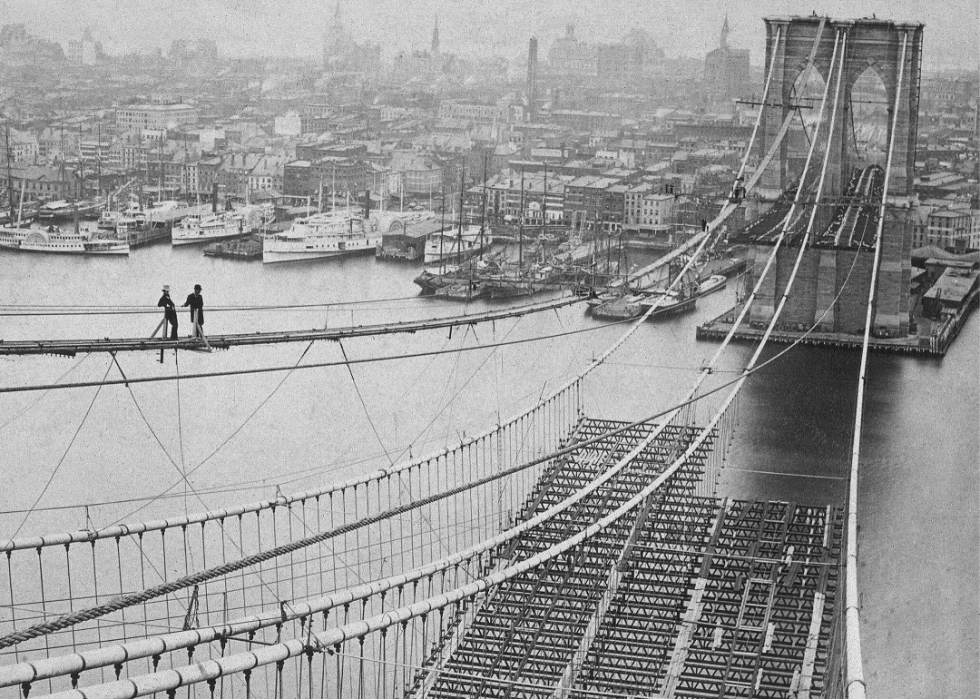
22 / 50
Photo12/Universal Images Group // Getty Images
1883: The Brooklyn Bridge under structure
New York's Brooklyn Bridge was constructed in the 19th century to connect Manhattan and Brooklyn over the Eastward River. The xiv-year long project, which would exist the showtime steel suspension bridge, was based on the designs of German-born civil engineer John Augustus Roebling. This photo shows the construction of the span as it nears its completion in 1883. The iconic part of the New York skyline took 600 workers and cost more than $320 1000000 in today'south dollars.
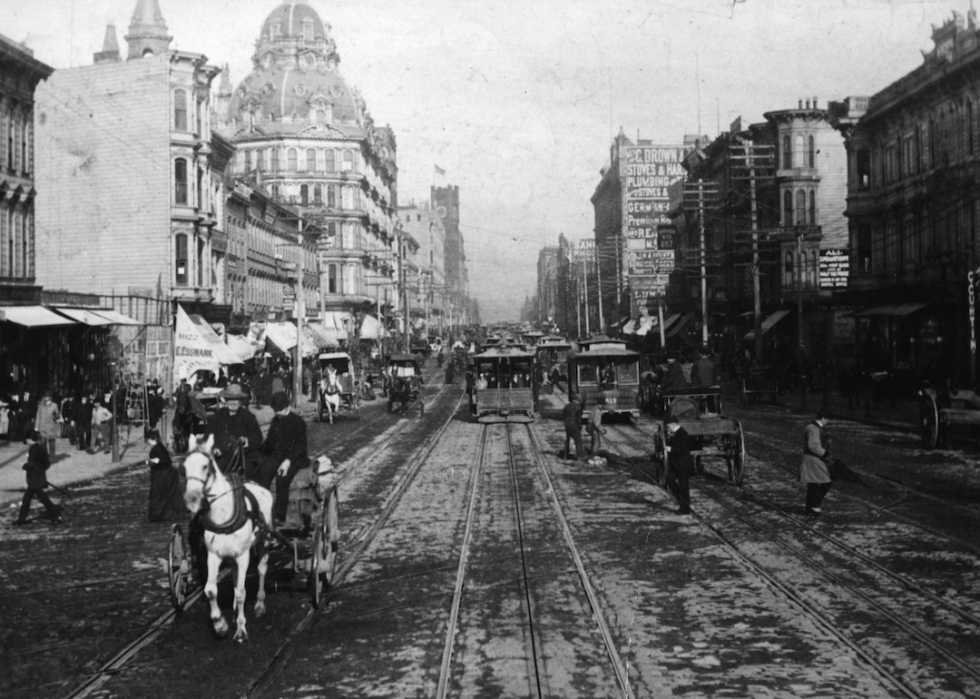
23 / l
Hulton Annal // Getty Images
1892: Tram on San Francisco's Market Street
Congenital to serve as a more efficient alternative to the horse-drawn wagons and cable cars of the time, electric streetcars emerged as a mode of San Francisco transportation in 1892. This photo shows a department of the streetcar line along Market Street, which was the origin of the line that and so ran through the Mission District and Glen Park to end in the Colma cemeteries.
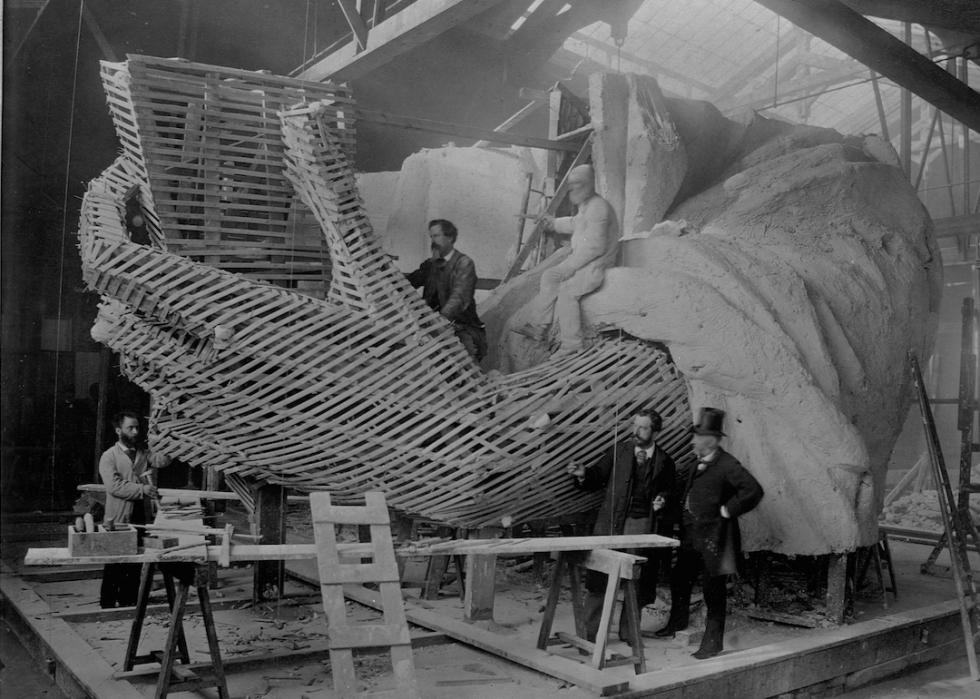
24 / 50
Library of Congress/Corbis/VCG // Getty Images
1882: Sculpting of a Statue of Liberty model in Paris
While the Statue of Liberty is an iconic symbol of New York and American liberty at large, the statue was designed by a Frenchman. Frédéric-Auguste Bartholdi created the Statue of Liberty upon a suggestion from Édouard de Laboulaye—also known as the "Father of the Statue of Liberty"—who wanted to create a monument that would symbolize freedom and democracy in the post-Ceremonious State of war historic period. Here, Bartholdi works on the left hand of his large-scale statue in a Parisian warehouse.
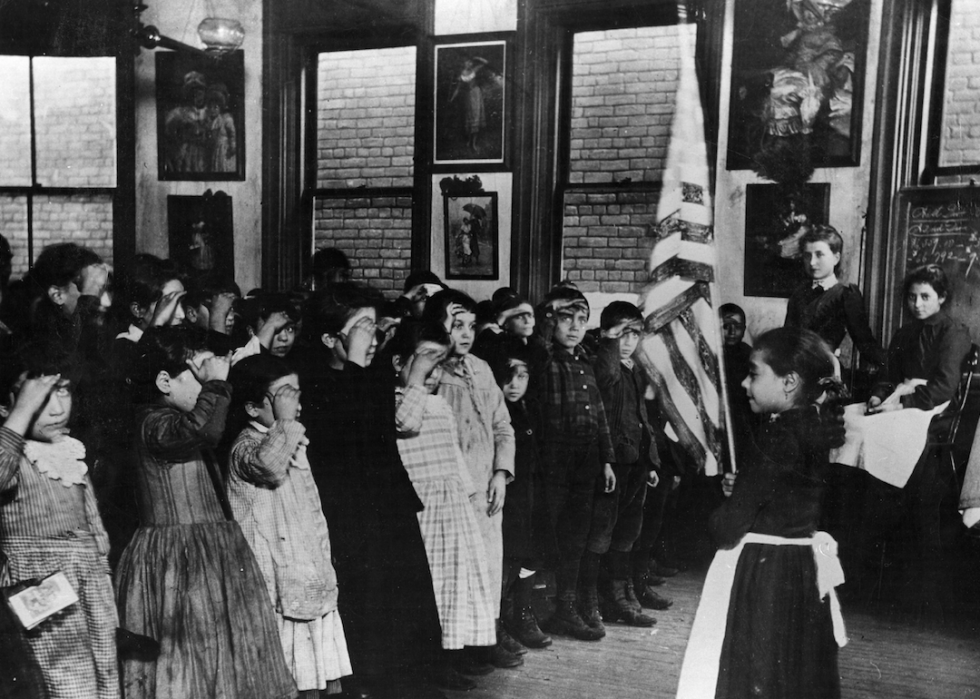
25 / 50
Jacob A. Riis // Getty Images
1887: Students in New York schoolhouse salute the flag
The influx of European immigrants in America during the 19th century caused a rise in slum communities, where those with limited resource were left to fend for themselves with few employment options or protective legislation. With ane major result of the slums being a lack of adequate instruction for children, the Children's Aid Order built a serial of industrial schools between the 1880s and 1890s.
These schools were meant to assist have children out of slums and provide them with a strong education and moral foundation. In this photo, children from one of these schools—Mott Street Industrial School in New York—are shown giving the Oath of Allegiance. The image uses the so-newly developed technique of flash photography.
Yous may as well like: Where U.Southward. first ladies went to college
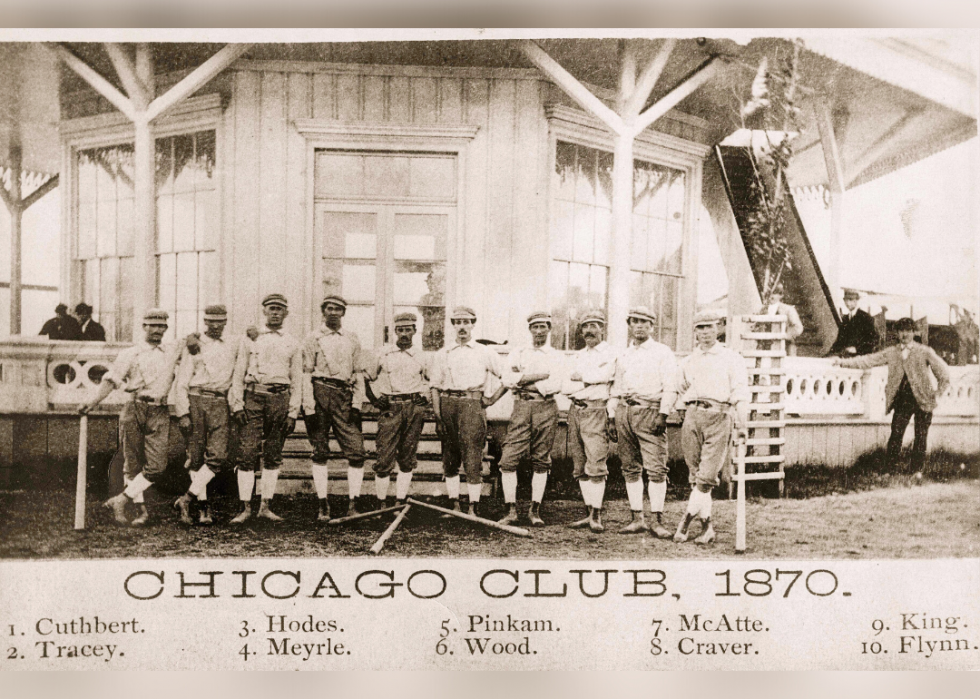
26 / 50
Transcendental Graphics // Getty Images
1870: Chicago White Stockings baseball order
This photograph shows the Chicago White Stockings baseball team, including star players William Craver and Levi Meyerle, equally they pose for a photograph on their Lakeside Park playing field in Chicago, Illinois. The White Stockings were the first professional team in the Windy City and served as the predecessors to the two well-known Chicago baseball teams that play for the city today: the Chicago Cubs and the Chicago White Sox.
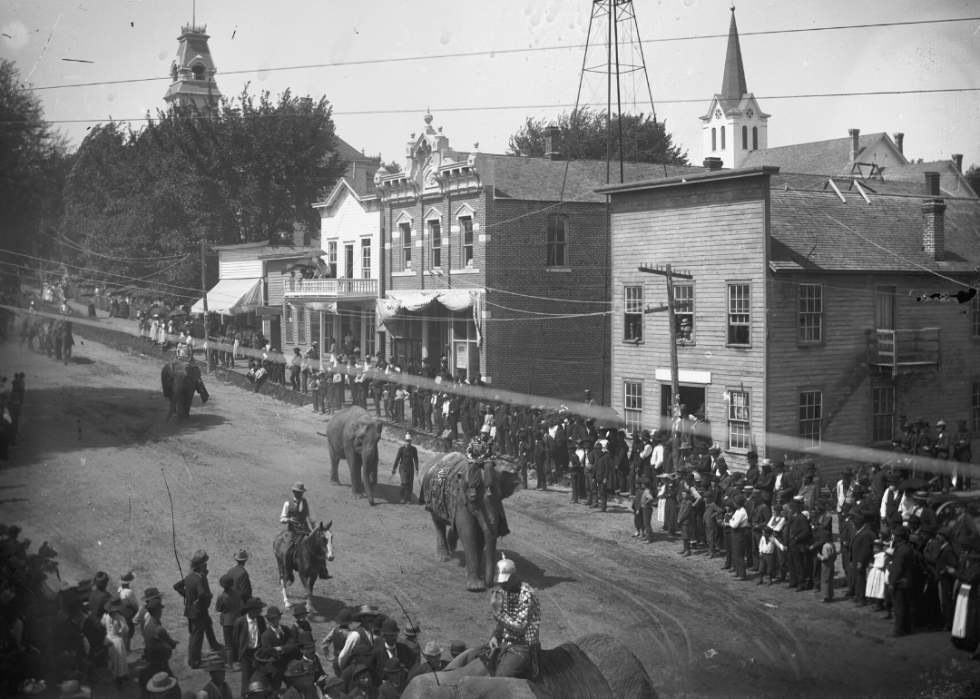
27 / 50
Charles Van Schaick/Wisconsin Historical Guild // Getty Images
1892: Ringling Brothers parade in Wisconsin
In the belatedly 1880s, families used to await the arrival of acrobats, exotic animals, and other performers on "Circus Day." Each fourth dimension that a circus came through town, their arrival would be marked by a parade forth the main street. In this photo, residents of Black River Falls, Wisconsin, line up on either side of Principal Street to scout the procession of the Ringling Brothers Circus, including several elephants.
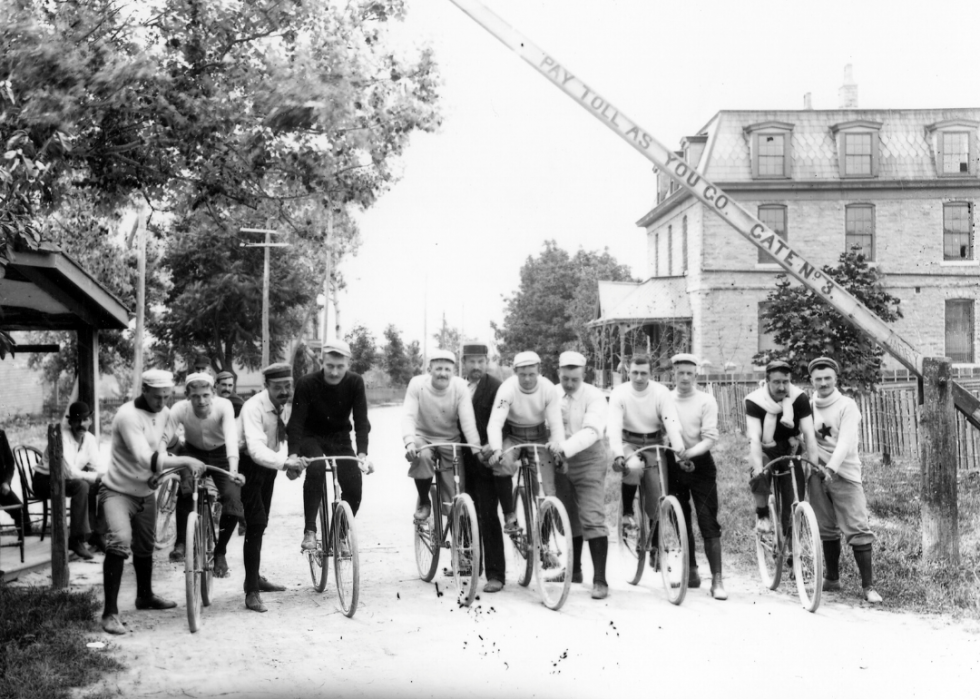
28 / l
Cincinnati Museum Center // Getty Images
1892: Brighton Bicycle Club members gear up to race
Before Americans had many transportation options beyond horse-drawn wagons and coaches, cycling became a uncomplicated and popular way for people to get around. The convenience and ascent ubiquity of cycling paved the way for the creation of wheel clubs across the country, where like-minded residents of a community formed an organization focused on wheel-forwards travel, exploration, and enjoyment. This photograph from 1892 shows members of the Cincinnati-based Brighton Cycle Club equally they prepare to race.
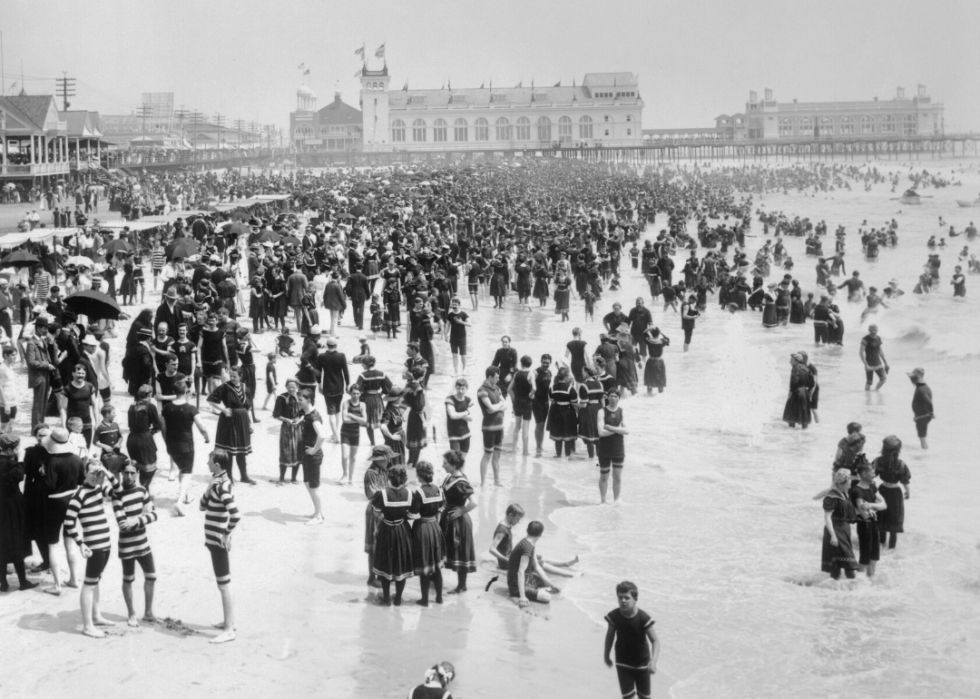
29 / 50
1899: Steel pier at Atlantic City embankment
With Atlantic Metropolis being the site of the get-go boardwalk in America, it's only plumbing equipment that the seaside city would also get home to the nation's kickoff waterfront entertainment park. Steel Pier was originally opened in 1898 by a local investment grouping, and rapidly became a pop attraction for locals and tourists. The pier enjoyed a number of milestones, including hosting the kickoff Miss America Pageant in 1921 and Frank Sinatra in 1950. In this photo, Steel Pier is shown in the center of a bustling beach in 1899, simply a year after its completed structure.
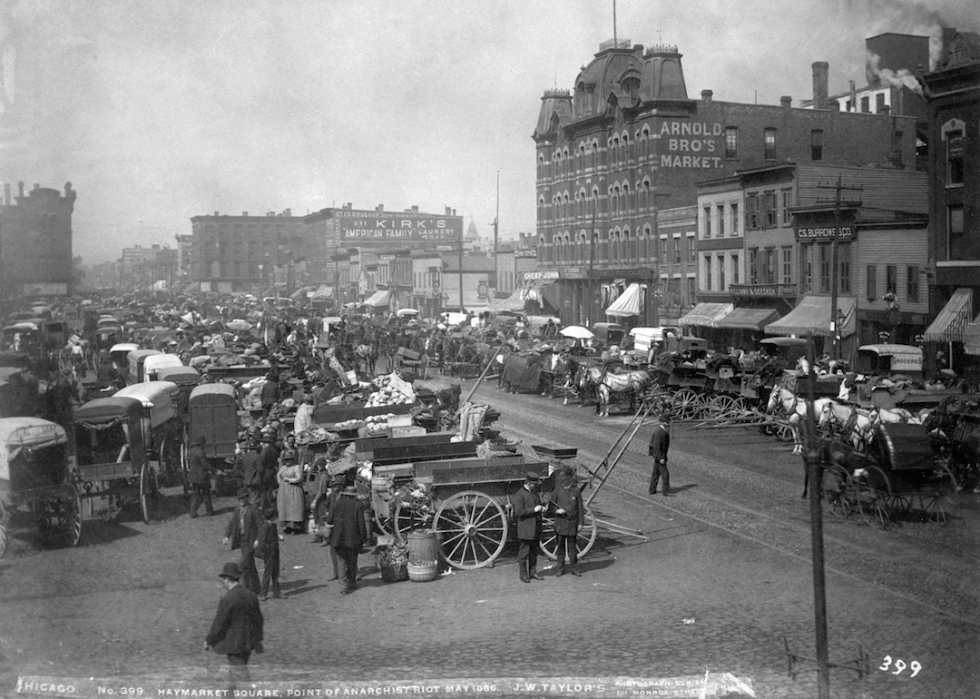
thirty / 50
Chicago History Museum // Getty Images
1886: Randolph Street Market in Chicago'southward Haymarket Foursquare
In April and May 1986, workers throughout Chicago—forth with unionists, socialists, and anarchists—assembled and took to the streets to demand a nationwide shift to an eight-60 minutes workday. Days of striking were interspersed with protest meetings, and on May 4, a sit-in that began peacefully on Des Plaines Street culminated in a violent disharmonism betwixt officers and citizens. The conflict left eight constabulary enforcement officials dead and endless more citizens injured and expressionless. This epitome shows the busy centre of Randolph Street Market in Chicago, just south of the 1886 anarchists' riot.
Y'all may also similar: Almost pop baby names for millennials
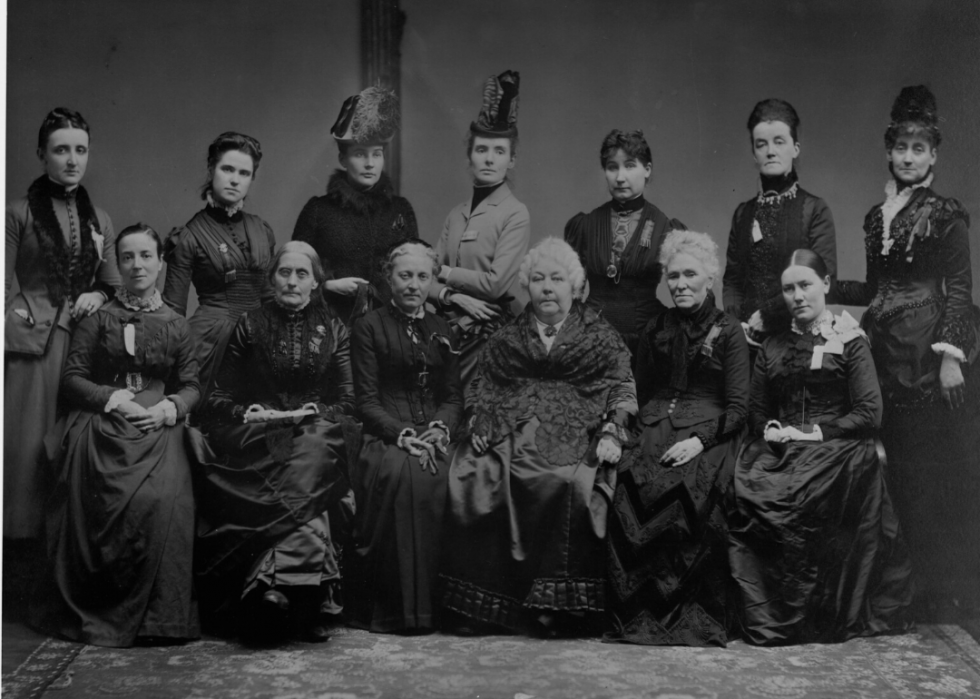
31 / 50
Library of Congress/Corbis/VCG // Getty Images
1888: Executive commission members of the International Quango of Women
The International Council of Women in 1888 became the first system of women to promote the advancement of women'due south rights and equality on an international level. The system'southward birth and activity was a natural result of the growing discourse around gender-based injustice that was taking place in the latter half of the 19th century. In this photograph, members of the organization's showtime executive committee, including famous women'due south rights activist Elizabeth Cady Stanton, are shown during their first coming together in Washington D.C.
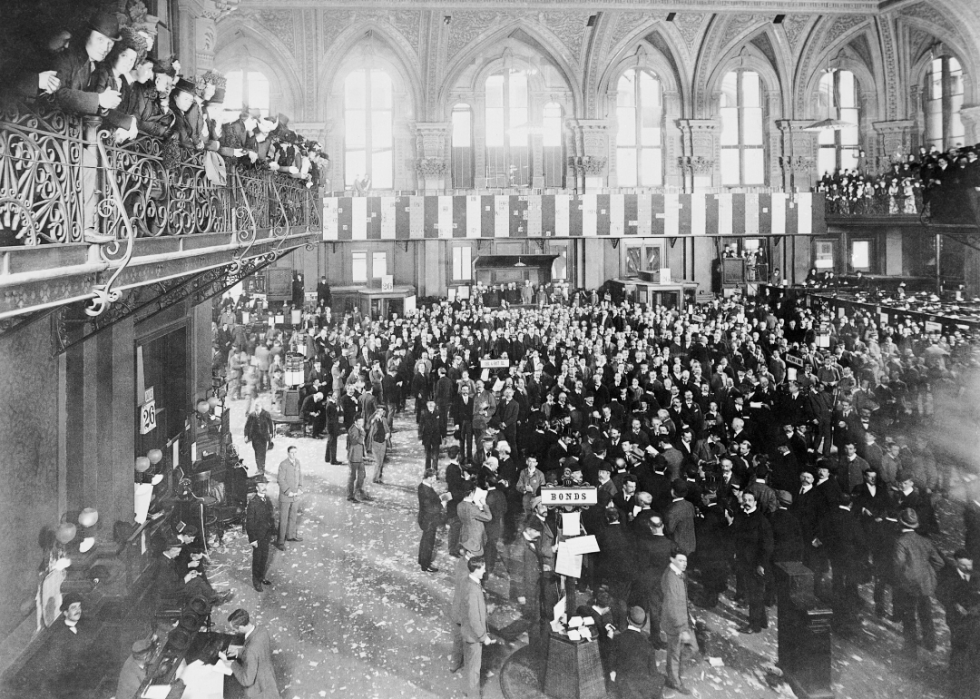
32 / 50
1889: New York Stock Exchange
Before the New York Stock Commutation came onto the scene, auctions were the closest matter to the kind of trading and exchanging that would establish a going charge per unit for goods and commodities. In May 1792, the Buttonwood Agreement, which was signed on Wall Street in New York Urban center, introduced the idea of a centralized substitution in the U.S. that would set a commission rate and eliminate the auctioneering culture of erstwhile. This photo shows the hectic floor of the New York Stock Substitution nearly 100 years afterwards its initial founding.
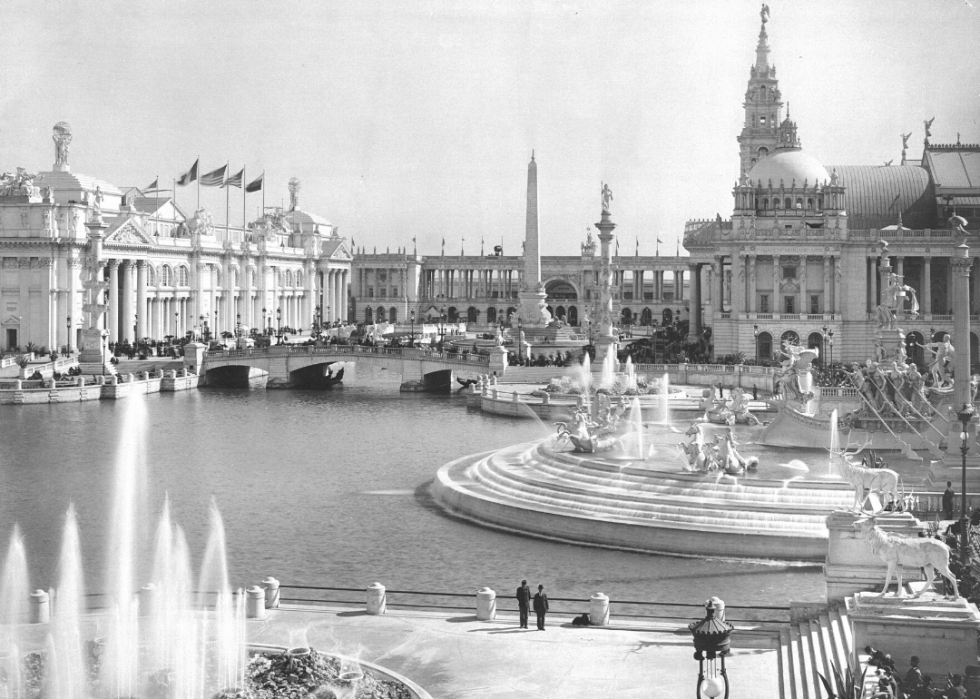
33 / 50
Chicago History Museum // Getty Images
1893: Peachy Basin at the Chicago World's Off-white
The Chicago World's Fair—likewise known equally the World'due south Columbian Exposition—was a six-calendar month celebration honoring the 400th ceremony of Christopher Columbus' arrival in North America. Among the many wonders on display at the off-white was the nation's first Ferris wheel, as well every bit its first encounter with electricity. This photo captures the view from beyond the Keen Basin, a sparkling lake in the center of the off-white's Court of Honor, which was expertly designed and decorated by a group of artists and architects.
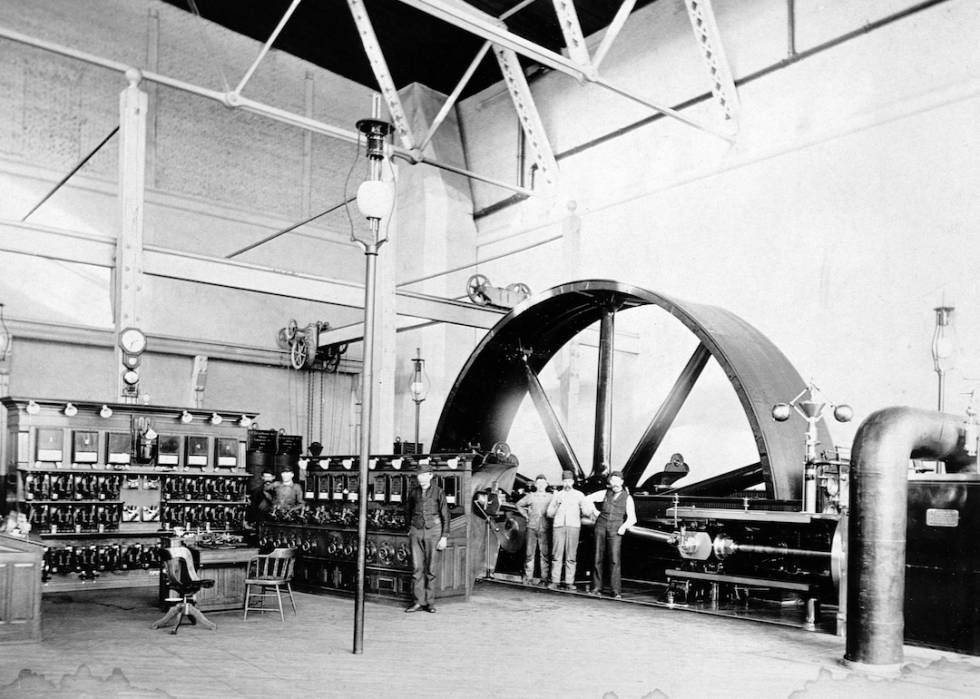
34 / 50
Minnesota Historical Society/CORBIS/Corbis // Getty Images)
1893: Steam electricity power plant in Minneapolis
When the concept of electric streetcars was first introduced in the mid-1880s, there were many who were reluctant to encompass the new technology. Despite the hope of faster, farther-reaching transportation, skeptics, including Thomas Lowry, who controlled the Minneapolis and St. Paul streetcar companies, were unsure most whether to utilize electrification and what information technology would mean as far equally rubber. Past 1892, however, all horse car routes in Minneapolis were electric, and the technology had more than or less taken over. In this photo, workers are shown continuing in a Minneapolis steam electricity plant, which powered many of the urban center's streetcars.
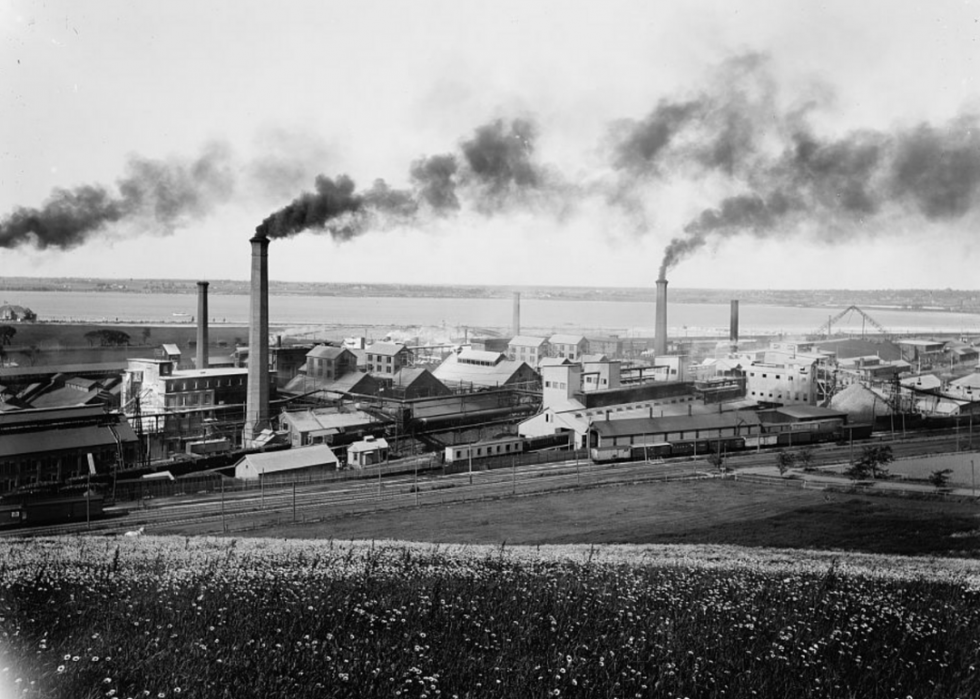
35 / fifty
Detroit Publishing Company // Library of Congress
1890: Solvay Process Co. in Syracuse
When the Solvay Process Company created a Syracuse-based chemical institute in 1881, it was the first U.Due south. facility to utilize the Solvay process to manufacture sodium carbonate. Solvay Process Co. ultimately paved a new path for the road of industrialization towards the cease of the 19th century. The found eventually developed soda ash, which could be used in the production of materials like glass and paper, too every bit products like soap.
You may too similar: Fastest-warming cities in the U.S.
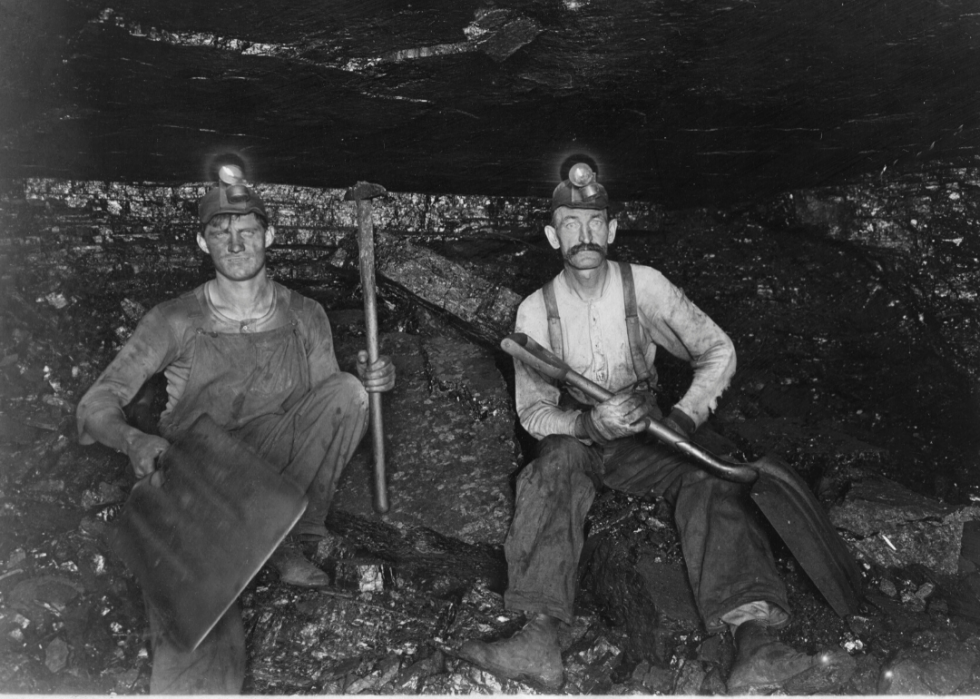
36 / fifty
Universal History Archive/Universal Images Group // Getty Images
1890: Coal miners in Pennsylvania
As industrialization largely shaped the 19th century, coal mining largely shaped the progression of industrialization. As ane of the cheapest and well-nigh efficient sources of fuel that could exist used for things similar trains and steam engines, the value of coal to the country'due south continued growth was extremely significant. Unfortunately, the job of coal mining was a barbarous one, and many men who took on the task—like those pictured hither in Pennsylvania—were often severely injured or killed during the procedure.
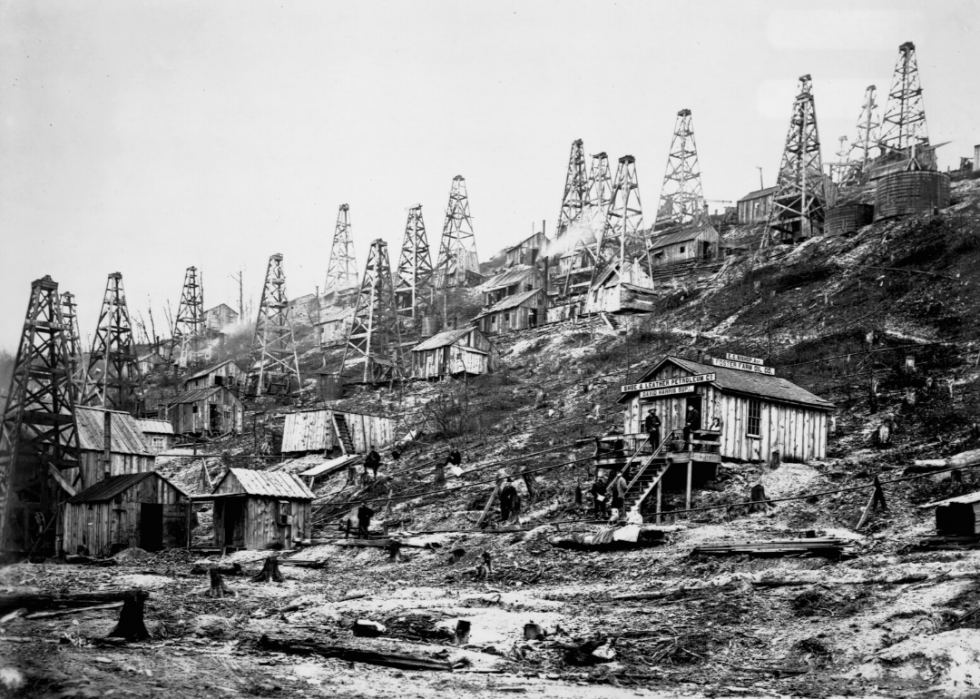
37 / 50
Mather & Bong/Library of Congress/Corbis/VCG // Getty Images
1895: Oil derricks on a hillside in Pennsylvania
While some people headed west to pursue precious minerals during the aureate blitz, others headed to Pennsylvania in the late 1850s to look for oil, or "blackness gold." The Pennsylvania Oil Rush started in 1859, afterwards oil—and, more importantly, its ability to supplant steam and coal equally a way of power and fuel—was start discovered. Here, a cluster of hillside oil derricks owned past the Shoe and Leather Petroleum Company and the Foster Farm Oil Company is photographed in Pioneer Run, Pennsylvania.
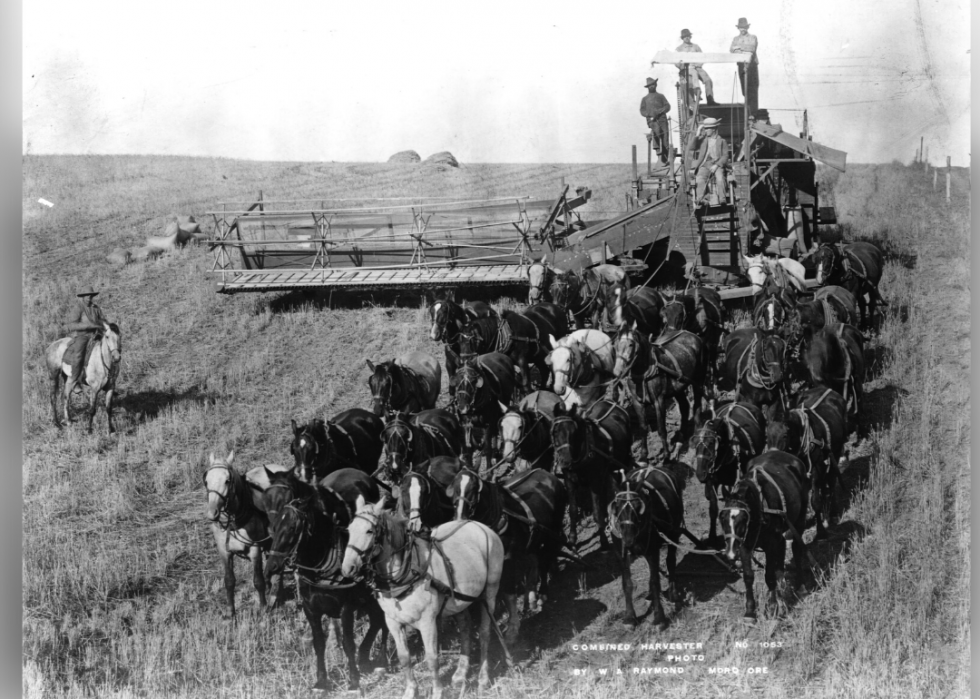
38 / l
W.A. Raymond/Library of Congress/Corbis/VCG // Getty Images
1890: Horse-drawn combine thresher harvests wheat in Oregon
The utilise of combine harvesters was new to America as of the 1860s. The farming technology combined the in one case-independent jobs of a header and a thresher, and thus significantly reduced the time and effort that information technology would accept a farmer to harvest wheat, corn and a number of other crops. In this photograph, the combine harvester is pulled through an Oregon wheat field by horses—though the process immune for fewer men to be involved, it could call for up to 40 horses—as it harvests the grain.
You may too like:How farming has inverse in every country the terminal 100 years
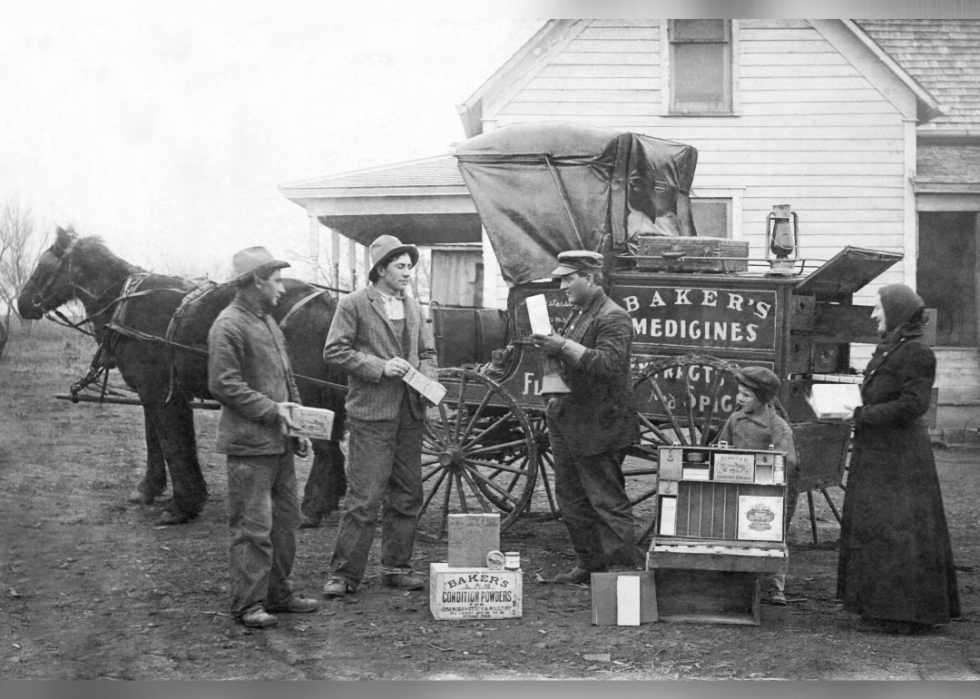
39 / fifty
Underwood Archives // Getty Images
1895: Traveling medicine salesman in Oklahoma
Earlier the widespread existence of brick-and-mortar stores where people could purchase their goods, traveling salesmen were rather common. This was specially truthful in areas around the Midwest that were slightly more than remote. In this image, a traveling salesman speaks to residents of a subcontract in Oklahoma as they peruse his powders and medicines.
Unfortunately, traveling salesmen were not e'er the well-nigh trustworthy. In the case of those peddling medicine, for instance, the popularity of "medicine shows" that traveled across the state and offered "phenomenon cures" that were sure to cure whatsoever number of ailments only preyed on the drastic to brand a profit, without offering any true medical benefit.
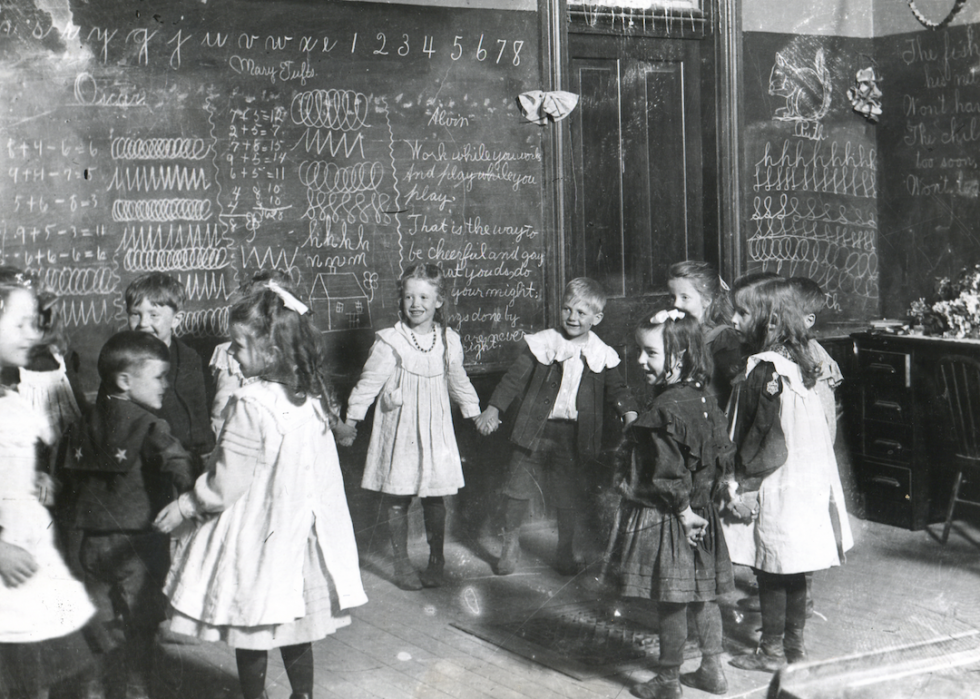
40 / l
Photoquest // Getty Images
1892: School children playing in their Iowa classroom
The quality of schools in rural Iowa in the 1890s was concerning to many who felt children were being disadvantaged by inferior teaching. This shortage of well-trained teachers was largely attributed to factors including subpar standards for instructor certification and low wages that left high-quality teachers disincentivized to educate children at Iowa schools. Children were ofttimes none the wiser, however, as is evident by this paradigm of simple schoolhouse children holding easily and playing a game in their Keota, Iowa, classroom.
You lot may as well like: American history from the twelvemonth you were born
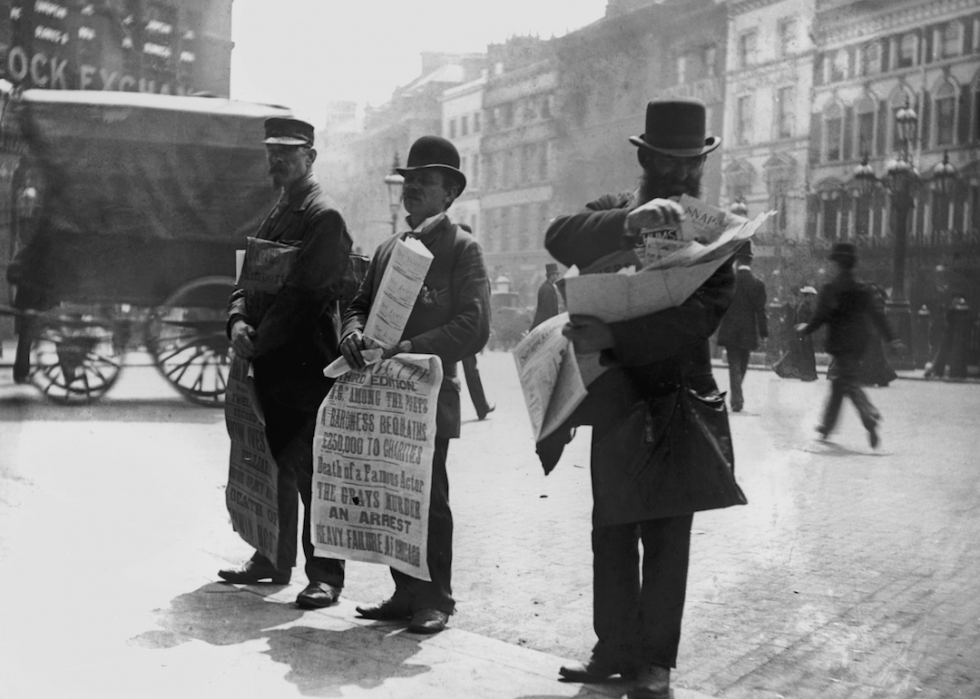
41 / 50
Hulton Archive // Getty Images
1893: Street vendors sell newspapers and comic books
Before the newsstand came to be, the news could be obtained from vendors simply standing on the street and selling it on the become. Hither, three men are photographed selling various forms of reading textile, including: "Snapshot" comic books; "Chums," a weekly newspaper for immature boys; and a paper featuring a front-folio story on the death of actor Edwin Booth, who was the brother of Abraham Lincoln'southward killer, John Wilkes Booth.
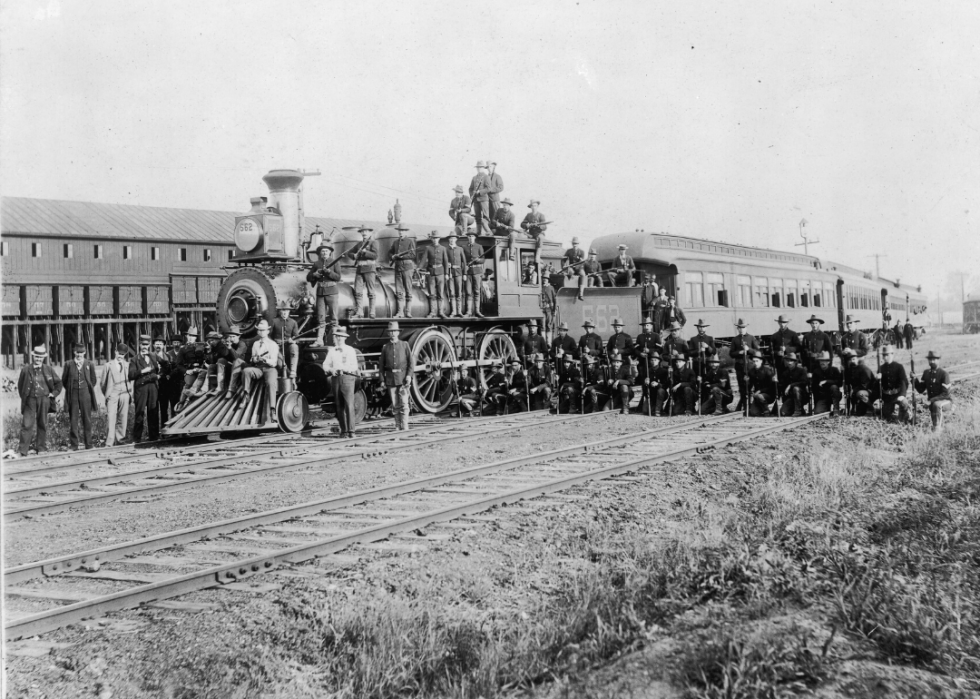
42 / 50
Fotosearch // Getty Images
1894: Federal troops during the Pullman Strike
At a point where railroad traffic was thriving and had drastically impacted transportation of individuals and goods across the state, any disruption to the railroads' regular operations had the power to drastically impede day-to-twenty-four hour period life. The Pullman factory strike in 1894 did just that. After having their requests declined during a wage negotiation, manufacturing plant workers of the Pullman Palace Car Company went on strike. The boycott was extremely detrimental to railroad traffic beyond the country and resulted in the offset example of regime officials and troops getting involved—as seen in this image—to break a strike.
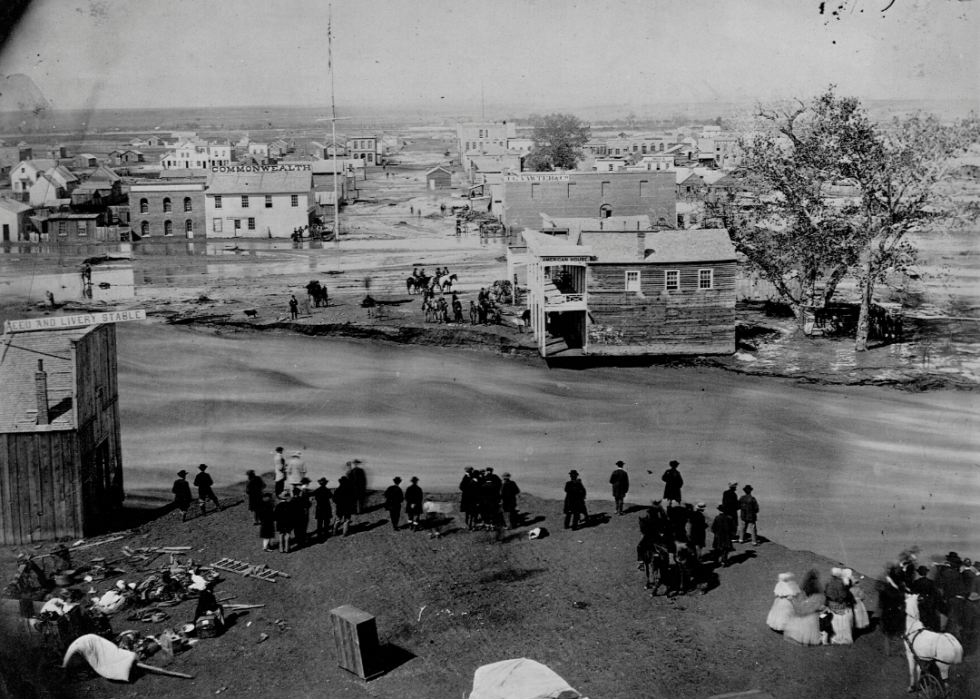
43 / l
George D. Wakely/Library of Congress/Corbis/VCG // Getty Images
1864: Denver's South Platte River during the Keen Flood
Tragedy struck Sheffield and surrounding regions in Colorado territory when, in 1864, a dam in one of four nearby reservoirs was breached, giving way for around 650 million gallons of water to escape in under an hour. The flood—known as the Great Sheffield Overflowing—killed 240 people and left homes and other buildings drowning under as much as 26 anxiety of water. In this photograph, people in Denver stand forth the shore of the South Platte river, which is rushing under the pressure of incoming water from the overflowing.
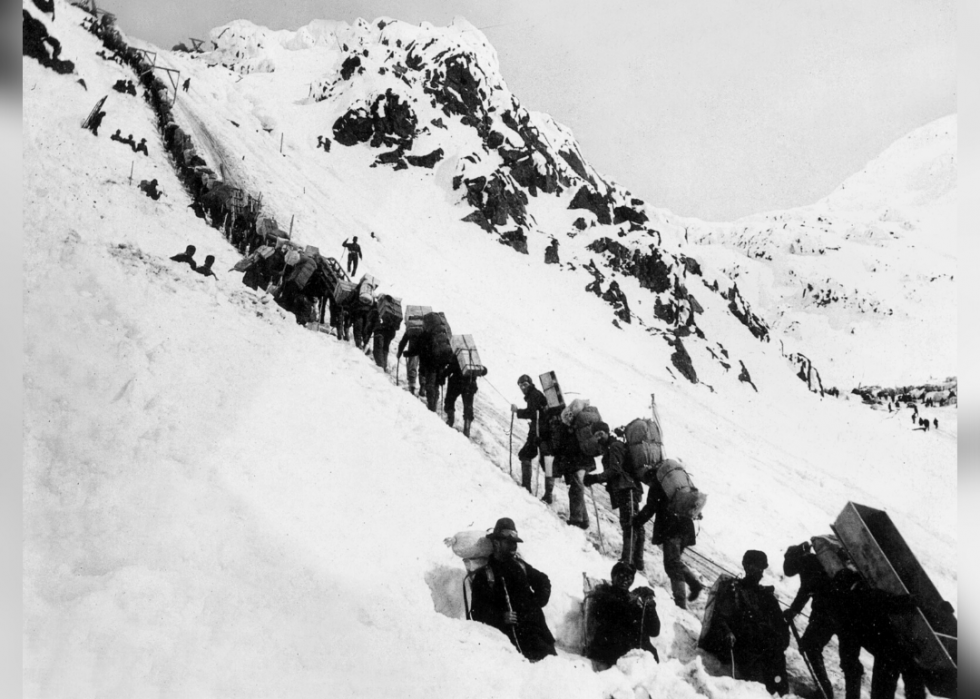
44 / 50
1898: Golden diggers climb Chilkoot pass in Alaska
Nicknamed the "Gold Staircase," Alaska's Chilkoot Laissez passer is a 26-mile trail that took hopeful—and incredibly brave—prospectors through the territory'south frigid weather during the Klondike Gilded Rush. This epitome shows gilt diggers trekking along the route in 1898, just two years after gold had been discovered in the Klondike region in 1896. Post-obit the initial discovery of gilded, more and more hopefuls attempted to brave the elements—including blizzards, avalanches, and freezing temperatures—to attempt their hands at finding gold deposits of their own at Klondike.
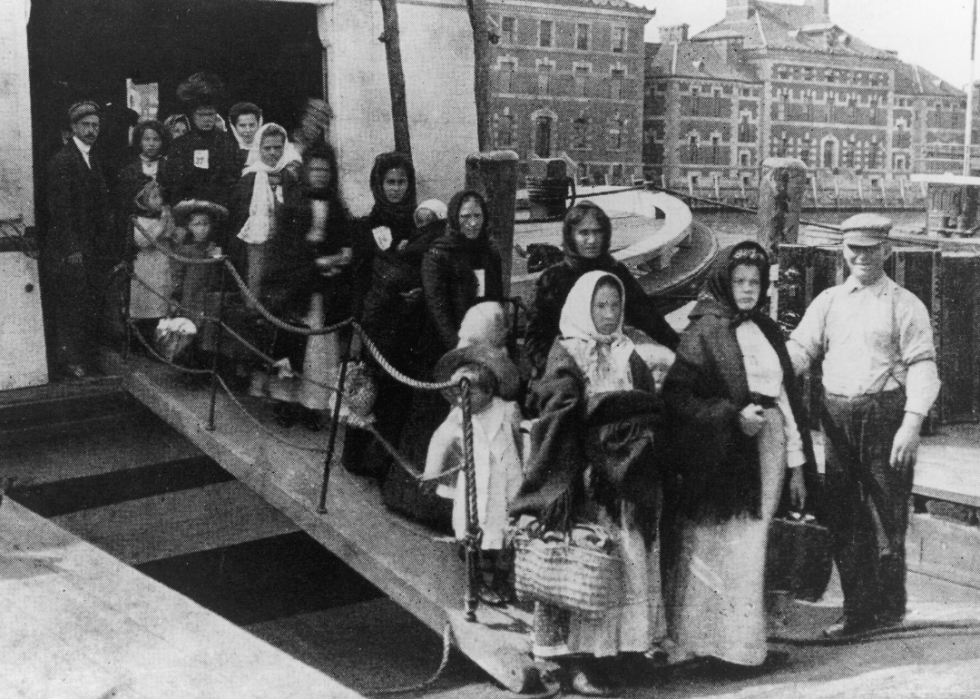
45 / 50
Fotosearch // Getty Images
1892: Ellis Isle opens
New York Harbor's Ellis Island first opened in 1892 and served as a point of entry for immigrants coming to America. It's estimated that more than 12 million immigrants arrived at Ellis Island in the 60-plus years that it was ushering newcomers into the country. With immigrants coming from throughout Europe, the migration of people to the U.S. that occurred through Ellis Isle marked ane of the first huge waves of incoming immigrants in the state. This undated photo (circa 1880) captures a group of people descending from a transport docked in the harbor as they enter Ellis Island.
You may also like:Clearing to America the year you were born
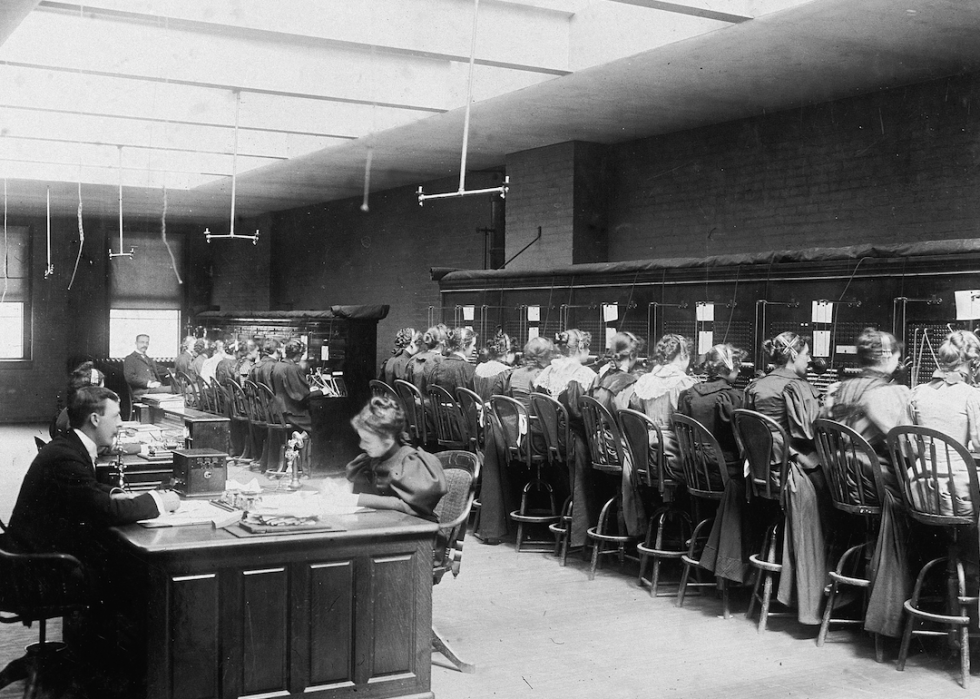
46 / 50
Museum of the City of New York // Getty Images
1896: Telephone exchange employees in New York
The first switchboard was created in 1878 out of a variety of random materials, including teapot handles and wagon bolts. Though it wasn't the most refined paradigm, the cosmos paved the fashion for the mainstreaming of telephones, which upwards until this bespeak had been somewhat express in their potential due to limited transmission technology.
With the switchboard in place, cantankerous-country telephone communication became far simpler, by connecting callers to a middleman who would straight calls from there. The switchboards, which needed to be operated manually, were often handled by women, as is axiomatic in this photo of employees at a phone commutation in New York City.
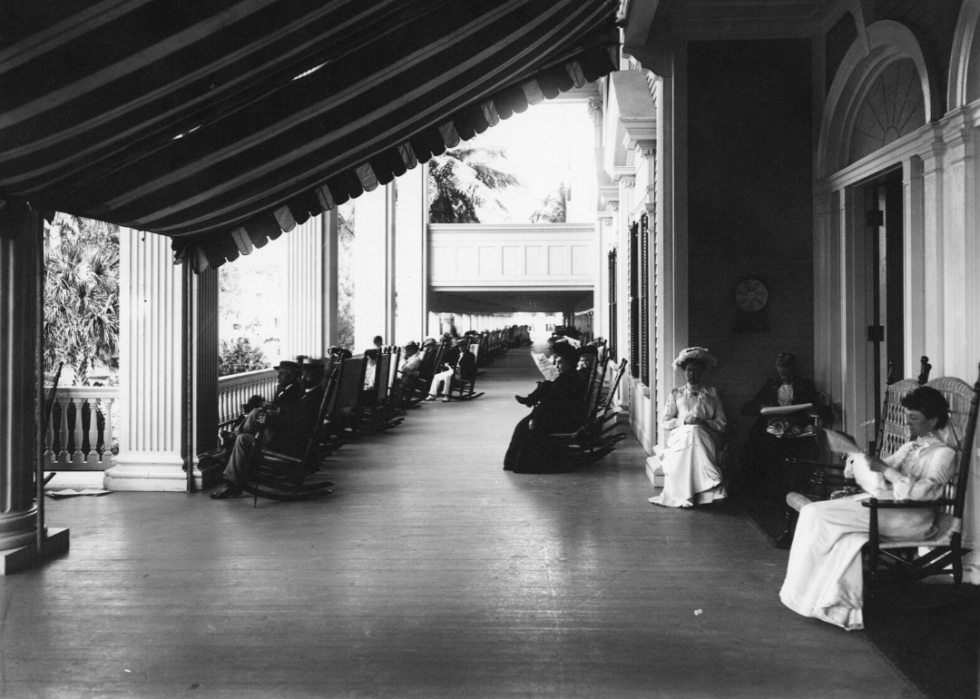
47 / 50
Geo. P. Hall & Son/The New York Historical Society // Getty Images
1895: Veranda of the Palm Beach Hotel in Florida
Earlier 1894, Palm Beach wasn't a top destination for beachgoers simply even so, but that changed when Henry Flagler came into the area and revitalized it with the construction of West Palm Beach's start resort: The Royal Poinciana Hotel. Other hotels, including the Palm Beach Hotel—pictured here with its yard terrace—and the Palm Beach Inn (known as The Breakers) also emerged to concenter wealthy visitors and encourage tourism in the county.
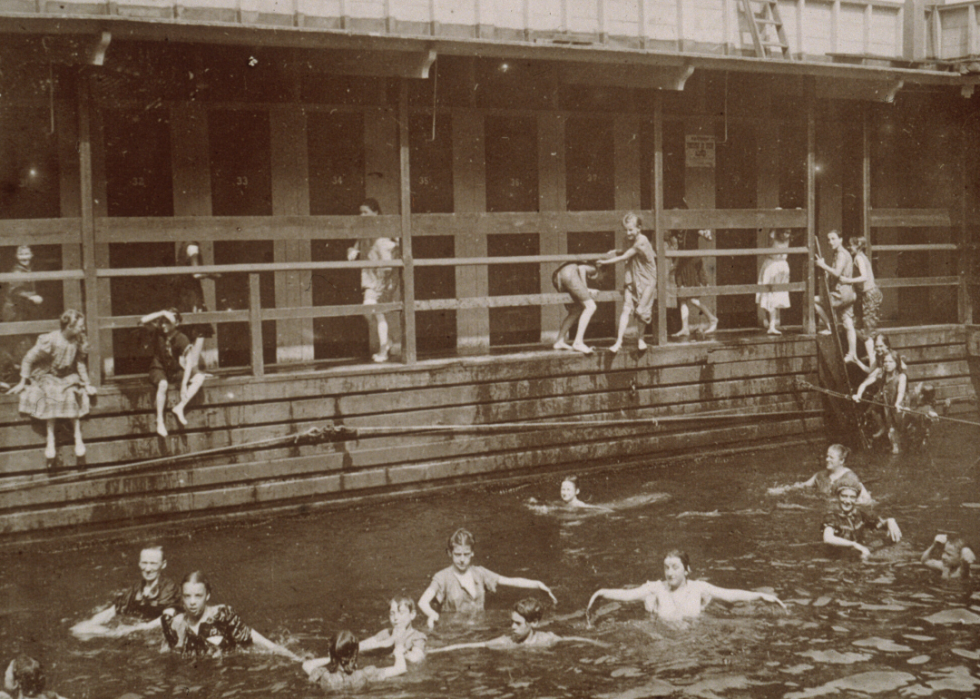
48 / 50
Jacob A. Riis/Museum of the Metropolis of New York // Getty Images
1895: Children swim at a public bath in New York
Record numbers of incoming immigrants during the belatedly 19th century in America created major crises of overcrowding in cities like New York, where space was express and populations were relentlessly rising. A event of the influx of new residents gave rise to tenement housing, which were multistory apartment buildings that crammed multiple families into living quarters with express space and facilities.
Tenement buildings that popped up in poorer neighborhoods of the metropolis were usually accompanied by public bathhouses, where family members could bathe and go on cool during hot summer months. Here, a group of children is shown playing and swimming in a public bath in New York.
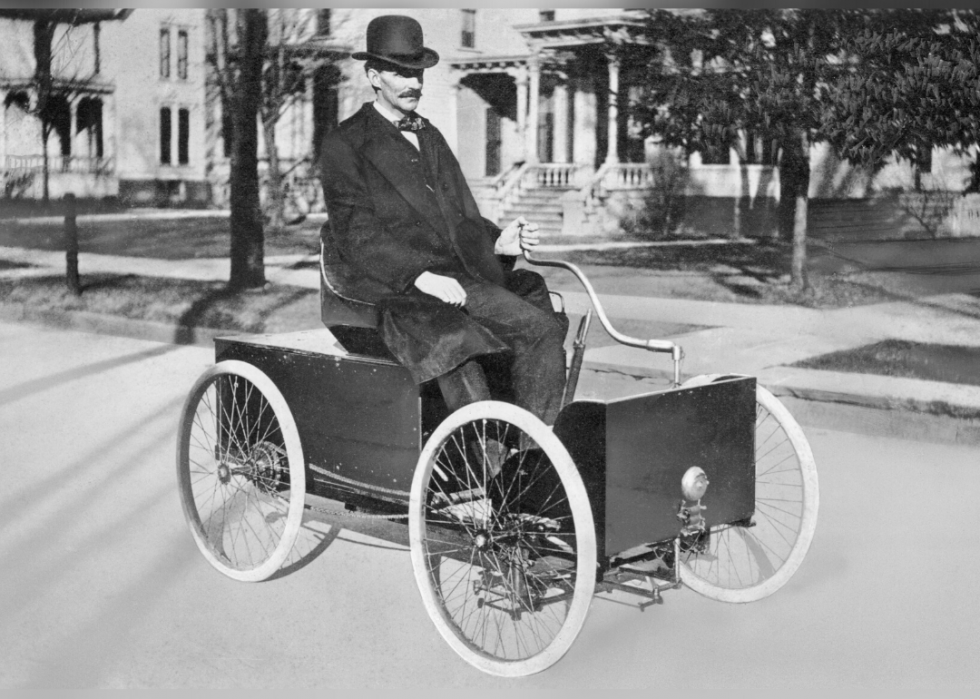
49 / 50
1896: Henry Ford drives his first auto
By the late 1800s, people had traveled by wagon, stagecoach, railroad train, tram, and trolley. Automobiles, however, had yet to enter the scene until 1896, when Henry Ford created the quadricycle, his kickoff attempt at a car that would run on gas. The automobile was synthetic using iron for the outer body and a leather chugalug and chain for its transmission. In this photo, Ford is pictured driving his kickoff car on Thou Boulevard in Detroit, Michigan. He later sold the vehicle for $200 and used the coin to build a second iteration of the prototype model.
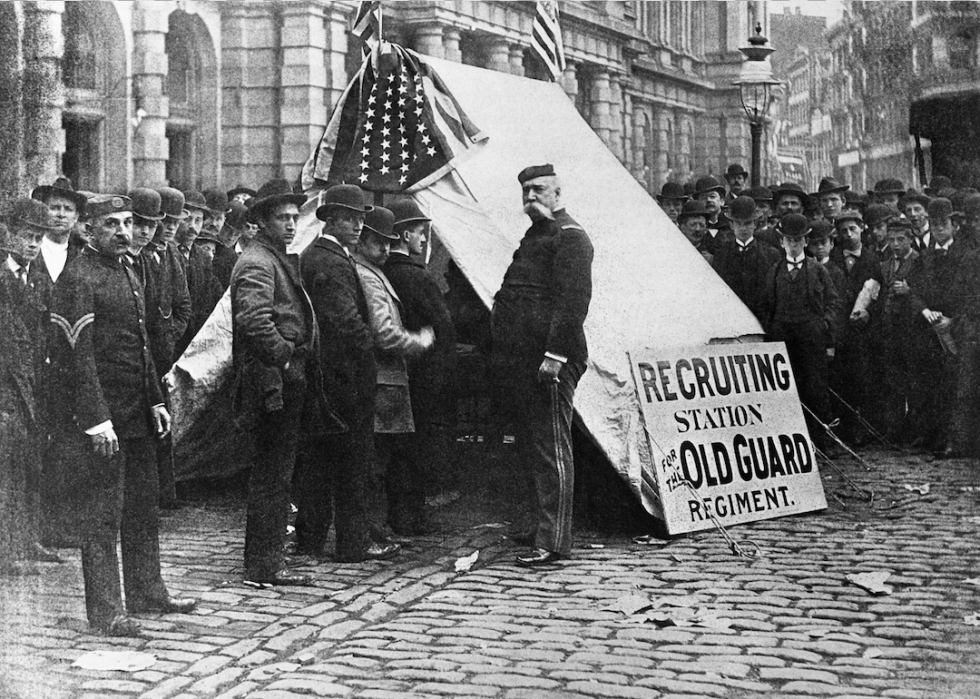
50 / fifty
1898: Young men recruited for Spanish-American War
Past 1895, Castilian colonial control was dwindling, with some of its few remaining colonies worldwide existence Cuba and the Philippines. The Castilian-American War occurred as a result of Cuba'southward fight to suspension free from Spanish rule; a fight that the U.S., in 1898, became involved in after pressure by popular demand. In this photograph, armed forces recruiters in New York try to enlist volunteers to fight in the war.
You may too like: fifty famous paintings and the stories behind them
Trending At present
© Stacker 2022. All rights reserved.
Source: https://stacker.com/stories/4000/50-photos-american-life-19th-century
0 Response to "17 Century American Art 17 Century American Landscape Art"
Post a Comment